TP11
Session assets
Orals: Thu, 22 Sep, 15:30–18:30 | Room Machado
The Claritas Fossae (CF) is a Martian system of scarps and troughs with NNE-SSE elongation that exceeds 1000 km of length and 150 km of width. It develops mainly in Late to Middle Noachian highland units and Hesperian lava flows (Tanaka et al., 2014). It is bounded to the east by the elevated plateau of Syria Planum, Sinai Planum and Solis Planum mostly consisting in late Hesperian volcanic units; and to the west by the relatively topographically lower Daedalia Planum made of the Amazonian-Hesperian volcanic lava flows of Tharsis (Fig 1a).
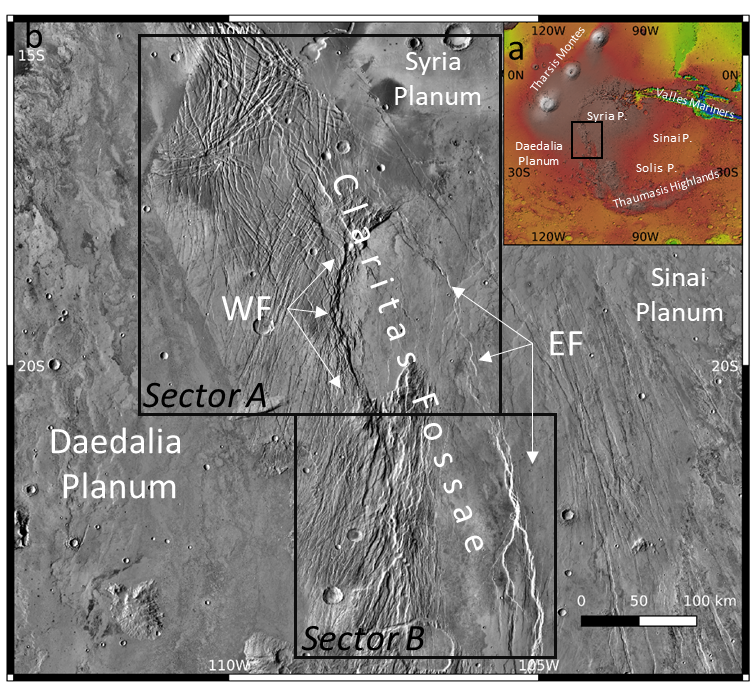
Figure 1 a) Location of the study area. b) The study area with its subdivision in the two Sectors A and B and the location of the Western Fault (WF) and the Eastern Fault (EF).
In this study, we focus on the northernmost part of the CF (Fig 1b) that can be subdivided in two different sectors (Hauber & Kronberg, 2005) on the basis of the characteristics of the main scarps and the valley floor:
- Sector A: It is characterised to the north and to the west by a topographically high area etched by numerous depressions up to tens of km long with different orientations, and to the south-east by an asymmetric valley. This valley is bounded to the west by an abrupt scarp, dipping to the east, that exceeds 200 km of length and presents up to 1000 m of elevation change. The eastern slope of the valley is represented by the northernmost part of a scarp here characterised by a maximum elevation change of 300 m and WSW dipping. These steep morphologies suggest a strong tectonic control; the faults responsible for their evolution are hereinafter referred to as the Western Fault (WF) and the Eastern Fault (EF), respectively.
- Sector B: The western slope of the asymmetric valley is gentler and with lower topographic contrast compared to Sector A lacking the topographic evidence of the WF. On the other side, the southward continuation of the EF presenting topographic changes up to 2000 m describes a steep scarp that strongly suggests its tectonic control.
The aim of this study is to reconstruct the tectonic processes that affected this area in order to gather a better comprehension of the tectonic style(s) that Mars experienced. In this perspective, a multi-scalar approach is of outmost importance. To do so, we conducted two types of analysis:
- Structural mapping of the regionally sized faults and fault-related fractures in Sectors A and B (still ongoing);
- Forward modelling aimed at reproducing the development in depth of the EF in Sector B.
For the structural mapping, we analyse satellite images that were processed to enhance the detectability of tectonic structures. The dataset we used, with different spatial resolution, includes: a) the topographic map of Mars from the Mars Orbiter Laser Altimeter (MOLA DEM and relative colour shade, 200 mppx); b) the Thermal Emission Imaging System dataset that shows the thermo-physical properties of the outcropping lithologies with InfraRed Day and Night acquisitions (THEMIS IRDay/Night, 100 mppx); and c) the Mars Reconnaissance Orbiter Context Camera mosaic (MRO-CTX, 6 mppx), used to explore the crosscutting relationships between the mapped structures. In addition, to better highlight the tectonic structures and to avoid limits and bias related to the use of a single lighting direction (Wise et al., 1985), we produced four shadowed images according to four synthetic lightening conditions (0°, 45°, 90°, 135°).
For the modelling of the EF, we consider the regional scale topography of the Martian surface as a reference layer reflecting the crustal tectonic processes. In fact, the erosional processes on Mars have very low rates, and have a negligilble effect in shaping the regional physiography (Klimczak et al., 2018). We used the HCA method (Salvini & Storti, 2004) aimed at reproducing the superficial morphologies by studying the movement of two crustal blocks separated by a fault with a given geometry. We modelled the topography derived from four topographic profiles trending perpendicular to the EF; results show that the activity of a crustal, listric normal fault replicates the topography across the CF. This crustal normal fault reaches the base of the crust at 80 km of depth, a value in accordance with literature (Watters et al., 2007). The dip of the fault decreases from about 60 degrees near the surface to about 20 degrees at the boundary between crust and mantle. The fault displacement varies from north to south, reaching a maximum of 2000 m.
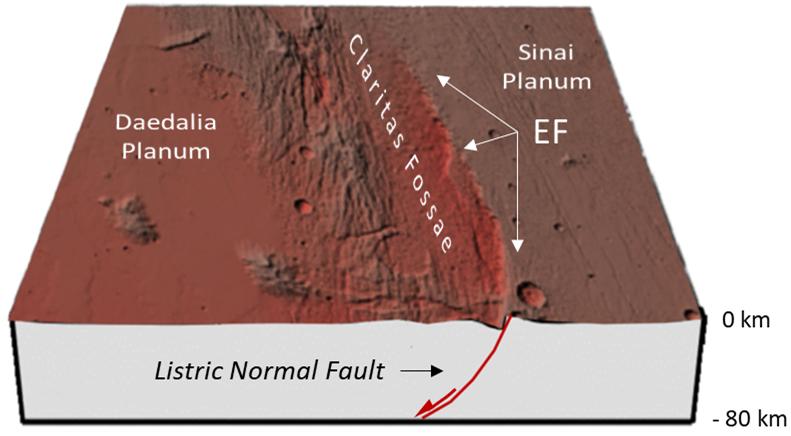
Fig. 2 – Sketch of the modelled listric normal EF
The preliminary results of the structural mapping show that the identified tectonic structures are not randomly distributed. The statistical analysis by frequency distribution of the mapped tectonic structures shows their clustering in four main azimuthal families: i) NNE-SSW; ii) NNW-SSE; iii) ENE-WSW; and iv) WNW-ESE. By analyzing the crosscutting relationships among the mapped structures and the relative ages of the terrains where they develop, we recognized multiple deformation events at different scale, both regional and hemispheric. Furthermore, by comparing the main trend of the found azimuthal families with the expected direction of the structures in a strike-slip regime (Li et al., 2016), we found correspondence with a right lateral strike-slip regime oriented NNW-SSE, similarly to the main scarps of the CF. The ongoing structural mapping and the spatial-azimuthal analysis of the family set will allow us to better constrain the relative chronology of deformation events and to produce a tectonic evolutionary model of the studied region.
These preliminary results suggest that the investigated area has been interested by a long-lasting tectonic deformation history made of multiple reactivations of crustal weakness zones. The structural setting of the area is likely related to the contribution of several factors acting also at different scales. At the hemispheric scale we recognized deformations associated to the development/evolution of Tharsis Bulge and of the Tharsis Montes; at the regional scale we recognized tectonic structures related to the evolution of the CF where evidence of strike slip and extensional deformations have been recognized.
How to cite: Balbi, E., Cianfarra, P., Ferretti, G., Crispini, L., and Tosi, S.: The Claritas Fossae region, an example of polyphasic deformation on Mars?, Europlanet Science Congress 2022, Granada, Spain, 18–23 Sep 2022, EPSC2022-1041, https://doi.org/10.5194/epsc2022-1041, 2022.
Surface deformation patterns on terrestrial planetary bodies have been interpreted as magma emplacement features due to their similarity with Earth analogues or their association with inferred eruptive products. Dome-shaped surface uplift features were recognized for example at floor-fractured impact craters on the Moon (Jozwiak et al., 2012), and at the Tharsis volcanic province on Mars (Farrand et al., 2011). The lack of subsurface geophysical data however precludes a clear observation of the characteristics and emplacement mechanisms of the inferred underlying magma intrusions.
On Earth, our insight into the characteristics of the magmatic plumbing systems that underly surface doming also remains cryptic due to the sparsity of observations. The most recent event was the hybrid explosive-effusive eruption at Cordón Caulle, Chile, in 2011. Pre- and syn-eruptive surface doming and pervasive ground fracturing observed there using satellite radar interferometry was interpreted there to result from the intrusion of a rhyolitic laccolith (Castro et al., 2016). Analytical and numerical models can use such geodetic observations to help estimate intrusion characteristics and assist in forecasting potential volcanic eruptions. The same models are used to infer shallow magma intrusion characteristics on terrestrial planetary bodies where the only observations available are surface topography and shallow ground-penetrating radar data.
Existing models generally assume that planetary crusts deform linearly-elastic, which leads to a simplification of the magmatic source geometry and the related displacement and stress fields. On Earth, however, host rocks around exposed solidified and exposed dykes, sills and laccoliths often show indicators of non-elastic deformation. Strain can accumulate along large-scale discontinuities in the overburden rocks, making the investigation of the emplacement mechanisms by traditional continuum models difficult.
To provide a more geologically realistic means of estimating magma intrusion characteristics and investigate the associated emplacement mechanisms, we have developed a numerical discontinuum model of laccolith emplacement within the framework of the “DeMo-Planet” project. We use the two-dimensional (2D) Discrete Element Method (DEM) model PFC2D (Itasca Consulting Group, Inc.) to represent the modelled medium as a particle-based network. We can use this model to indicate fracturing and highly discontinuous deformation, as well as visualizing the localization of subsurface strain and corresponding deformation.
Two stages of the model application are now available. In a first stage, a laccolith-shaped pressure source is inflated at the base of the host medium with varied depth of the magmatic source. In a second stage, particles are injected into the laccolith-shaped fluid body to simulate constant magma supply into a growing intrusion.
In this presentation, we will simulate laboratory tests to calibrate the mechanical behaviour and the relations between particle contact parameters of the numerical host rock and magma. To that end, we use the elastic property values (Young modulus) and tensile strength measured on host rocks estimated for the Moon and Mars (Heap et al., 2020). We then use elastic properties measured using uni-axial laboratory tests. The investigated rock samples were collected from exposed Permian sediments above Permian trachyandesite intrusions of the Intra-Sudetic Synclinorium in Poland. The calibration of the model with geological data then allows a comparison of the numerical results with field observations of the structural deformation in the intrusions’ overburden. In the future, we plan to analyze the effect of varying gravity, geometric and mechanical model parameters on the ratio of tensile to shear-mode fracturing, as well as investigating the magma-induced surface displacement in detail.
DeMo-Planet demonstrates a promising multidisciplinary approach of informing numerical models of complex, discontinuous magma emplacement processes in the heterogeneous and fractured shallow crust of terrestrial planetary bodies. The validation of this new modelling application with detailed structural information from representative Earth analogue sites will allow us to investigate the characteristics of the cryptic magma bodies underlying surface doming on the Moon and Mars. The application of our model to other terrestrial planetary bodies will simultaneously improve the interpretation of volcanic unrest signals on Earth.
References
Castro, J.M. et al. (2016) “Rapid laccolith intrusion driven by explosive volcanic eruption,” Nature Communications, 7, p. 13585. doi:10.1038/ncomms13585.
Farrand, W.H. et al. (2011) “Spectral evidence of volcanic cryptodomes on the northern plains of Mars,” Icarus, 211(1), pp. 139–156. doi:10.1016/j.icarus.2010.09.006.
Heap, M.J. et al. (2020) “Towards more realistic values of elastic moduli for volcano modelling,” Journal of Volcanology and Geothermal Research, 390, p. 106684. doi:10.1016/j.jvolgeores.2019.106684.
Jozwiak, L.M. et al. (2012) “Lunar floor-fractured craters: Classification, distribution, origin and implications for magmatism and shallow crustal structure,” Journal of Geophysical Research E: Planets, 117(11), pp. 1–23. doi:10.1029/2012JE004134.
How to cite: Poppe, S., Morand, A., Harnett, C., Awdankiewicz, M., Cornillon, A., Heap, M., and Mège, D.: Discontinuum modelling of magma emplacement below surface doming on the Moon, Mars and Earth analogues from the Polish Sudetes, Europlanet Science Congress 2022, Granada, Spain, 18–23 Sep 2022, EPSC2022-872, https://doi.org/10.5194/epsc2022-872, 2022.
Introduction
We modeled the sequence of discontinuities forming in the subsurface due to dike intrusion with the objective of understanding the possible mechanisms of dike-induced graben nucleation. We did this at three sites in the Elysium Mons region of Mars: Galaxias Fossae (GF), Elysium Fossae (EF) and Cerberus Fossae (CF). From our results we propose to general models of graben nucleation above dikes under Martian conditions.
Methodology
Firstly, we used cross-section area balancing on MOLA topographic profiles across one graben in each site to obtain approximations of dike geometry, mainly, aperture (a) and top-dike depth (Dd) (Rivas-Dorado et al., 2020). Because these parameters are sensitive to fault angle, for each location we used three values: 55, 60 and 65º. Then, for each of these we used three sets of mechanical properties, corresponding to a weak, intermediate, and strong host rock, as inputs for the dynamic models. In each model, driving stress is increased step wise and at each step the following processes take place. First, the composite dike-induced stress field is calculated considering both the dike’s driving stress and the lithostatic load (Pollard and Segall, 1987). Then, the principal stresses ( and ) are calculated from the total dike-induced stresses. Finally, and are used in the modified Griffith failure criterion to determine which points in the grid are at failure, and if this is the case, their mode and orientation. At the end of the model, a sequence of discontinuities forming between the dike tip and the surface has been recorded. This methodology was applied to all three sites, which resulted in 27 models.
Results
14 models were found to be compatible with the nucleation of dike-induced faults, from which we propose two general models. We define compatible models as those in which the discontinuities form through a sequence, and at an orientation and location, which are compatible with the inferred present-day faults.
The first generic model corresponds to narrow and relatively shallow dikes emplaced in a low-compliance host rock (Fig. 1a). In this case, fault nucleation occurs through the coeval propagation of mode-I tensile cracks from the surface to depth, and of mode-II discontinuities formed under general compression or tension-compression, from the dike tip to the surface. In this scenario, the dike driving stresses are relatively small and tension cracks dominate over 50-65 % Dd. The second model corresponds to wider and deeper dikes emplaced in a higher-compliance host rock (Fig 1b). In this scenario, fault nucleation occurs through the propagation of near-surface mode-I cracks to depth, and mixed-mode I-II plus mode-I discontinuities from the dike tip to the surface, which lead to the formation of high-angle faults. The required dike driving stresses in these models are larger, and the section between the dike tip and the surface is dominated by tensile structures, which occupy >65% Dd.
We also ran equivalent models under Martian versus terrestrial conditions to explore the differences in the style of growth of the discontinuities. We found that under terrestrial conditions the extent of the tension-dominated section is narrower and restricted to the near surface, <20% Dd, and that fault nucleation requires a larger participation of mode-II discontinuities. This is because of the greater contribution of the lithostatic stresses which, in general, make tensile failure at depth more difficult.
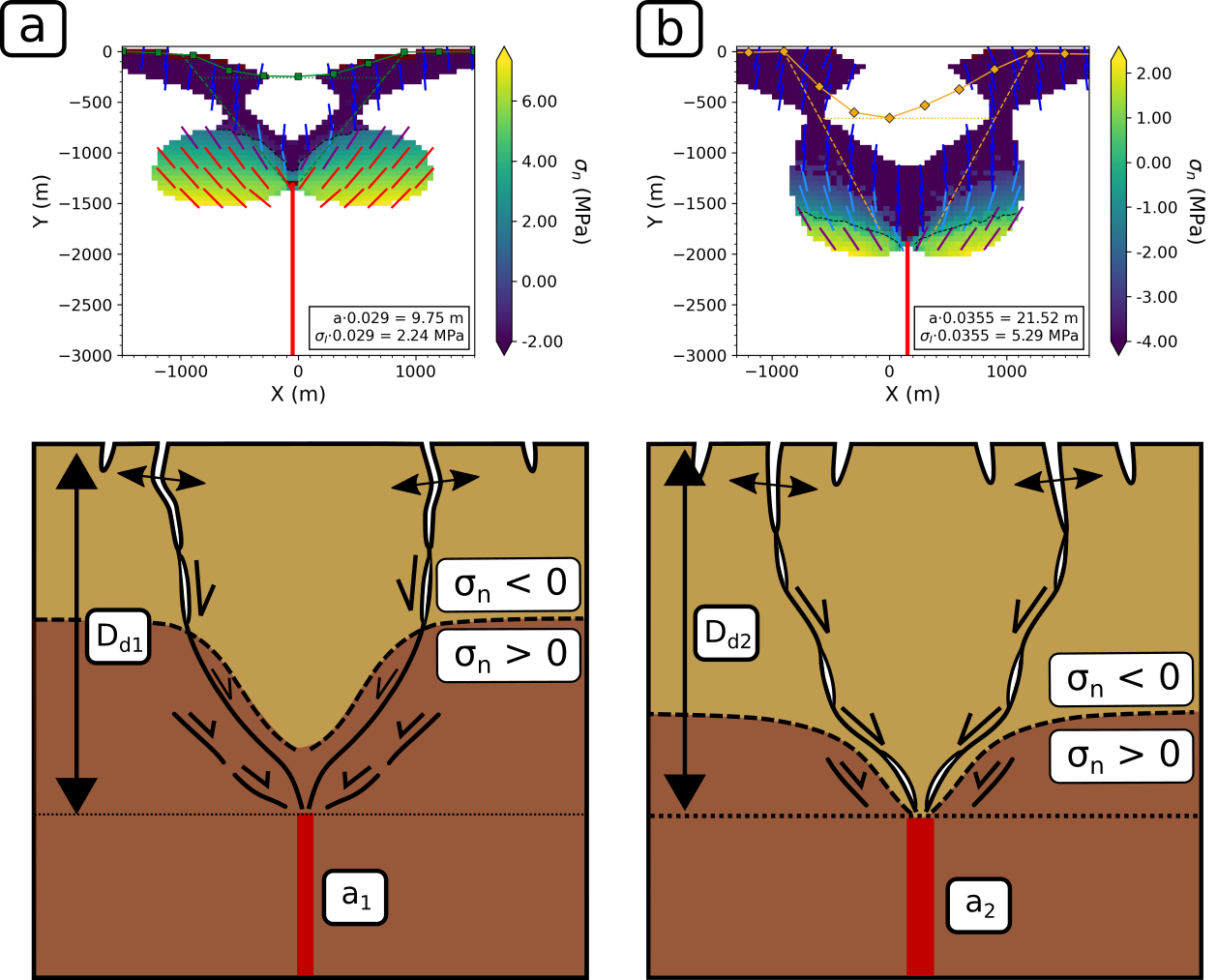
The results of our models are consistent with several numerical and analogue models, and with multitude of observations. For example, mapping of the displacements along dike-induced graben in the Exmouth plateau, through high-resolution 3D seismic, frequently reveals two points of maximum slip along many faults. This indicates that these have grown from two nucleation points, one shallower and one deeper, as proposed in both our generic models (Magee and Jackson, 2020, 2021). Although comparisons with terrestrial models and observations must be made with caution, since they respond to dike emplacement under different pre-diking conditions, the observed similarities support our model results.
Conclusions
We performed several dynamic models of the discontinuities formed during the emplacement of dikes under different conditions, at three locations in the Elysium Mons region of Mars. From these we propose two generic models of dike-induced graben nucleation: 1) shallow, narrower dikes emplaced in a weaker host rock in which both tensile cracks and faults participate in fault nucleation, and 2) deeper, wider dikes emplaced in a stronger host rock, which generate faults in a dominantly tensile regime. These results can be reconciled with models of dike-induced deformation, and with observations in real case studies. However, our models only address the question of early fault nucleation. Further research and modelling efforts are required to understand later dike-induced graben development and the processes associated with it, such as long-term post-diking seismicity. This may be key to understand the origin of the marsquakes currently being detected by InSight in the Elysium region, and specifically, in the vicinity of Cerberus Fossae.
We constructed dynamic models of the fractures and faults formed around an intruding dike by considering both the dike and lithostatic stresses. From these we propose two distinct conceptual models of graben nucleation with different participation of faults and fractures; one in which shallower and narrower dikes nucleate graben through both faults and tensile cracks, another in which deeper and wider dikes generate graben mostly through the linkage of mode-I fractures.
References
Magee, C., Jackson, C., 2020. Seismic reflection data reveal the 3D structure of the newly discovered Exmouth Dyke Swarm, offshore NW Australia. Solid Earth 11, 579–606. https://doi.org/10.5194/se-11-579-2020
Magee, C., Jackson, C.A.L., 2021. Can we relate the surface expression of dike-induced normal faults to subsurface dike geometry? Geology 49, 366–371. https://doi.org/10.1130/G48171.1
Pollard, D.D., Segall, P., 1987. Theoretical displacements and stresses near fractures in rock: with applications to faults joints, veins, dikes and solution surfaces, Fracture Mechanics of Rock. Academic Press Inc., London. https://doi.org/https://doi.org/10.1016/B978-0-12-066266-1.50013-2
Rivas-Dorado, S., Ruiz, J., Romeo, I., 2020. Subsurface Geometry and Emplacement Conditions of a Giant Dike System in Elysium Fossae, Mars. J. Geophys. Res. Planets n/a, 2020JE006512. https://doi.org/https://doi.org/10.1029/2020JE006512
How to cite: Rivas-Dorado, S., Ruiz Perez, J., and Romeo Briones, I.: Two mechanisms of graben nucleation above dikes based on elastic and frictional models applied at three locations in the Elysium Rise, Mars, Europlanet Science Congress 2022, Granada, Spain, 18–23 Sep 2022, EPSC2022-556, https://doi.org/10.5194/epsc2022-556, 2022.
INTRODUCTION
In recent years, the Martian world has drawn the attention of researchers all over the globe. Mars’ rich geological record and fascinating history led scientists and space organisations to be keen on studying the planet more closely. Several studies on Mars are primarily focused on determining the potential for life. (Nazari-Sharabian et al., 2020). The similarities between Mars and early Earth are a big part of why people want to study it. Little has changed on Mars since the Hesperian epoch, 2.9 billion years ago, due to the lack of plate tectonics (Victoria et al., 2018). As a result, unlike Earth, it is possible to look at Mars as a blank canvas due to no artificial structural advancements. The discovery of geological features that resemble small valleys and river plains (Rice et al., 2008) has only raised the possibilities of finding water on Mars in some form. Many dramatic events occurred on Mars' glacial past, leading to the construction of valleys, river plains, glacial landforms, and other features. We have recently learned a lot more about such features.
Mars’ extreme glacial history led to significant changes and the formation of interesting features such as glacial-like landforms on the planet. Changes in the orbital and rotational parameters have allowed ice from ice-rich polar regions to shift towards the equator (Mischna et al., 2003). This process is termed mid-latitude glaciation (Hepburn et al., 2020; Milliken et al., 2003). Furthermore, these formations have flow-like geomorphology as shown in figure 1, indicating the presence of ice underneath these landforms (Holt et al., 2008; Souness et al., 2012). Examining the depths of these GLFs may yield information on the events that have manifested in significant geographical and climatic changes.
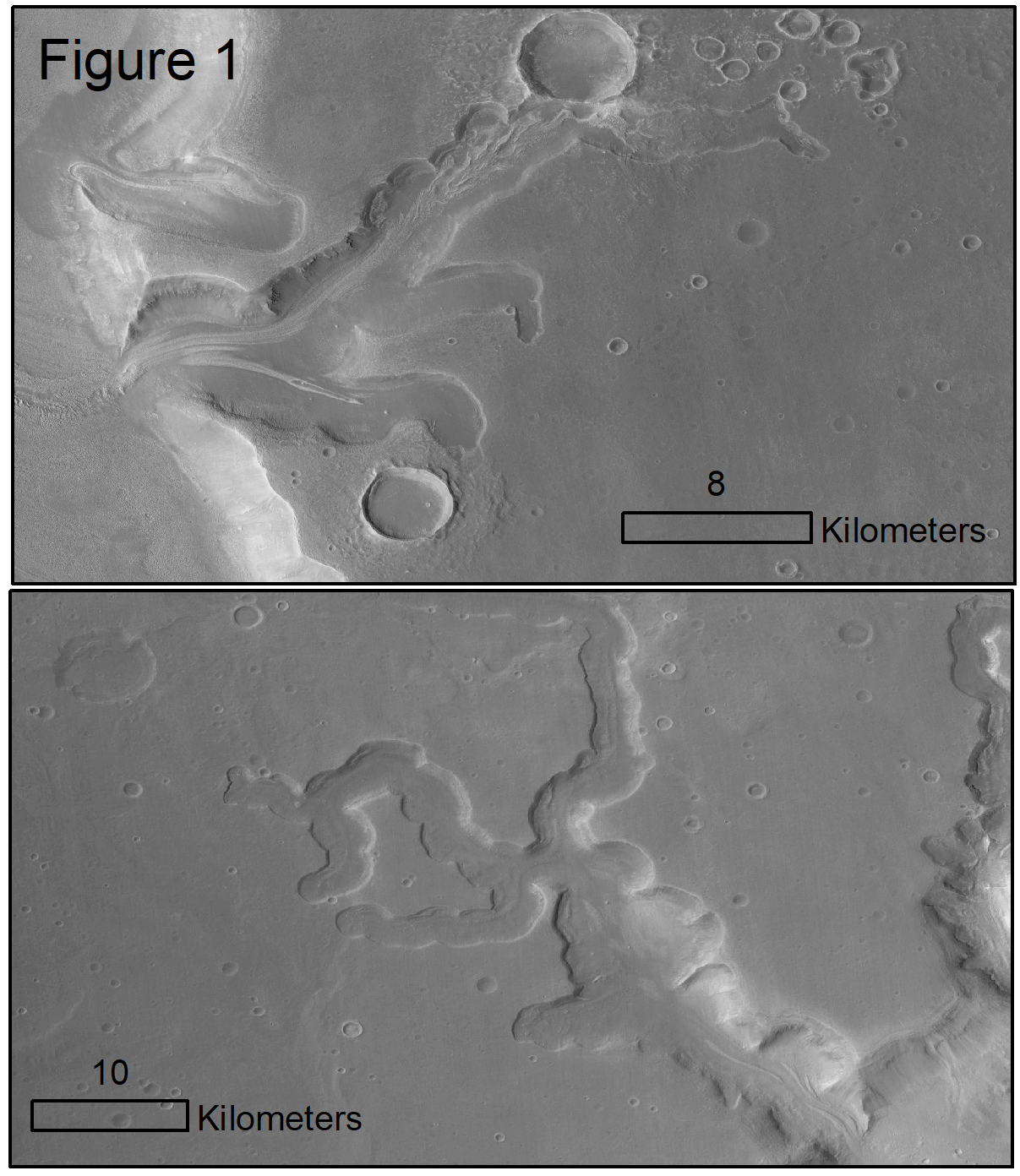
1.1 Research Gaps and Objective
There are studies that focus on the GLFs and their formation over the years (Degenhardt and Giardino, 2003; Holt et al., 2008; Karlsson et al., 2015; Souness et al., 2012). Attempts to date these viscous flow features by studying their composition (Hepburn et al., 2020) have resulted in some progress in understanding Mars' glacial past through these landforms. However, there is still a lack of knowledge of the depths of the GLFs. The reasons for the absence or presence of any buried deposits beneath these landforms are largely uncertain. Although there have been papers targeting these landforms and layers underneath them, there is a requirement to evaluate their complete potential through the extension of radar datasets. Because the undersurface deposits on Mars are mostly dust and dirt (Dundas et al., 2018), detecting them with optical images is difficult. Therefore, this study attempts to examine the depths of glacier-like forms in the mid-latitudes of Mars using SHARAD radargrams.
1.2 Data
The Shallow Subsurface radar instrument on Nasa's Mars reconnaissance orbiter produces very long wavelength radar imagery and can be utilized to detect subsurface layers on Mars. Unlike Earth, ice on the mid-latitudes of Mars sublimates when on the surface and can be found underneath the surface (subsurface). Therefore, to confirm or reject the presence of subsurface deposits on Mars, SHARAD's pulses are used for better penetration of signals into the target landforms. SHARAD’s radar pulses can reach up to 1000-1500 m depth and operate between 15-25 MHz frequencies. The data obtained by the instrument are in the form of radargrams which can be used for geospatial analysis. As shown in figure 2, the radargrams represent power returned at several time delays (Y-axis) along the track of the distance traveled by spacecraft (X-axis) (Bramson and Petersen, 2020). There is an increase in the power (at the time delay) returned from the radar if contrast is realized in the material properties. A material's response can be expressed by dielectric constant or permittivity and is related to the material's refractive index.
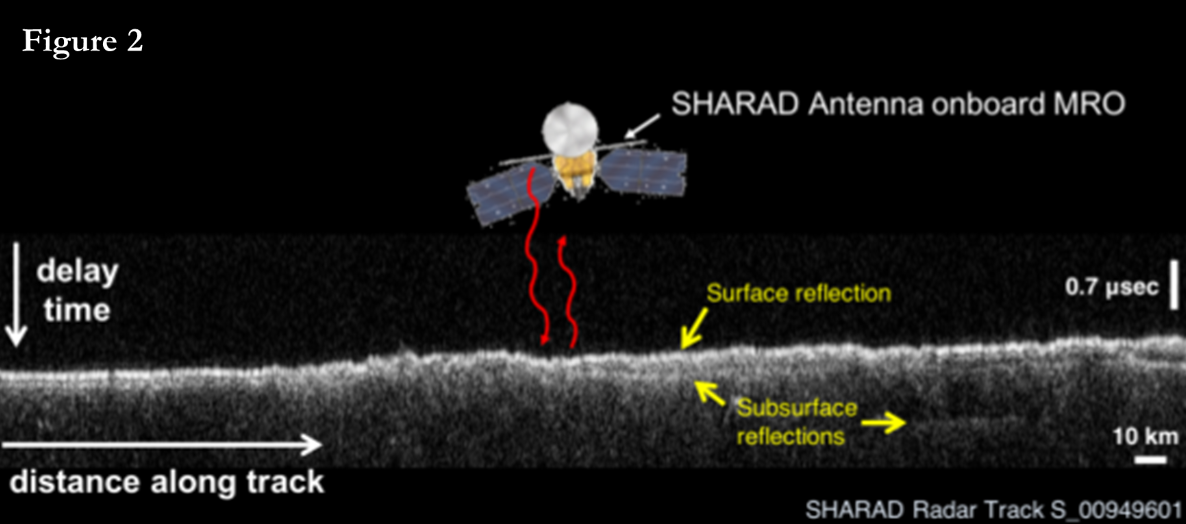
1.3 Methodology
1.3.1 Target glacial-like forms
Most small-scale lobate debris aprons, i.e., features that stretch for less than 5 km, are present in the Northern Lowlands (Hepburn et al., 2020) as shown in figure 3. The selection of a few interesting GLFs is made based on the evidence of hydrous minerals in the area. In the study (Pan and Ehlmann, 2018), Deuteronilus Mensae is closely studied for phyllosilicates and hydrated silica using CRISM images. In this study, the target landforms are selected based on the locations of these hydrous minerals shown in Pan and Ehlmann’s research.
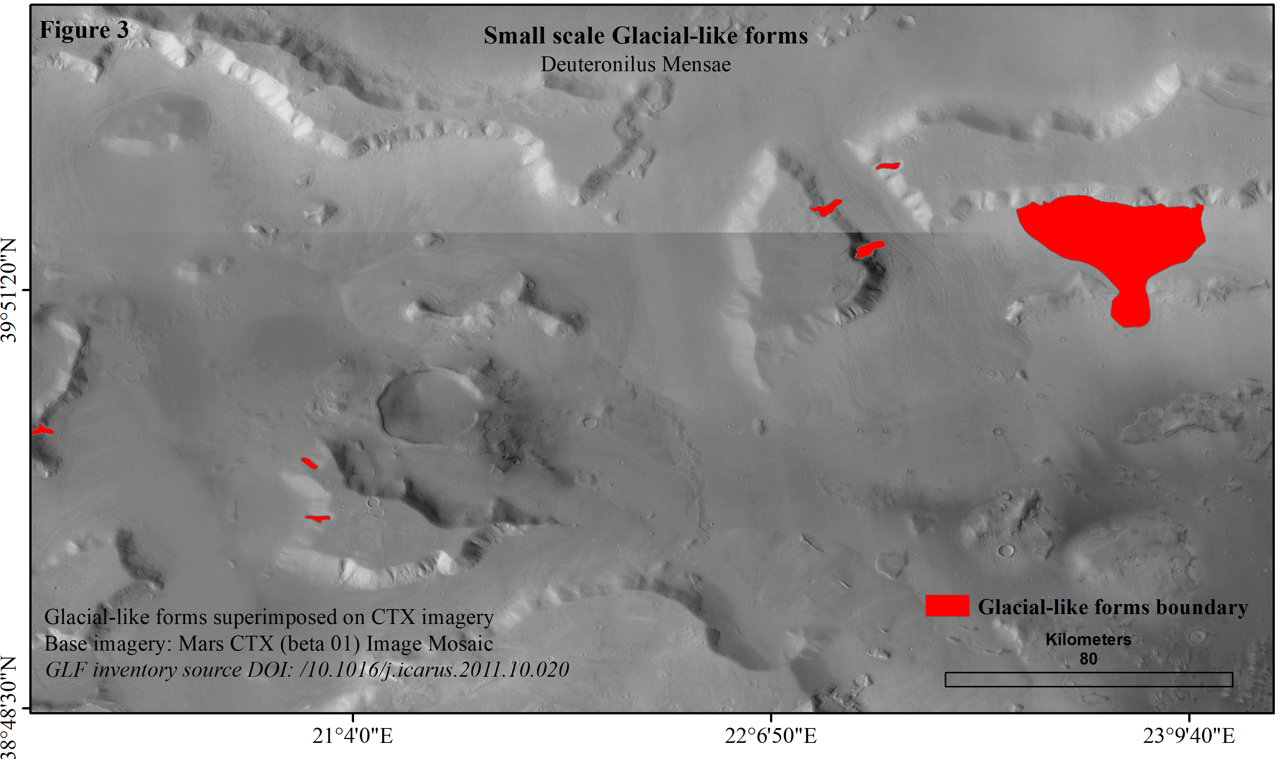
1.3.2 Processing Radargrams
Off-nadir reflections: The performance of the radar sounder is determined by several factors, including surface and subsurface reflectance, receiver noise level, and topography. At longer delays, topographic features away from the nadir track will add undesired noise or "clutter" power (Seu et al., 2007). Therefore, topographical changes can induce different levels of clutter echoes. Bright reflections from off-nadir surface topography cause radar clutter, resulting in late returns that could be misinterpreted for subsurface returns (Bramson et al., 2015). Hence, we compare our radargrams to their respective clutter simulations produced using Mars Orbiter Laser Altimeter.
1.4 Results
In figure 4 original radargram covering a GLF rich in Fe/Mg phyllosilicates in the Deuteronilus Mensae region is shown along with the Themis mosaic indicating the cross-section profile of the radargram. The radargram is compared to a clutter simulation generated using the Colorado SHARAD Processing System. The subsurface reflections can be recognized with the use of clutter simulations. Specific subsurface interfaces are visible in the radargrams directly under the GLFs which are absent in the simulations. This indicates the presence of subsurface deposits under the phyllosilicate-rich GLF.
However, utilizing SHARAD radargrams to look under small-scaled GLFs has inherent difficulties, and due to resolution restrictions, it is difficult to look closely at the radargrams. Deuteronilus Mensae has a complex terrain; hence, in some instances, subsurface reflectors are very similar to the surface reflector caused due to the instrument’s sidelobes (Bramson et al., 2015). Therefore, the radargrams need to be very carefully compared with the simulations to grasp better what can be called a subsurface deposit under the target landforms.
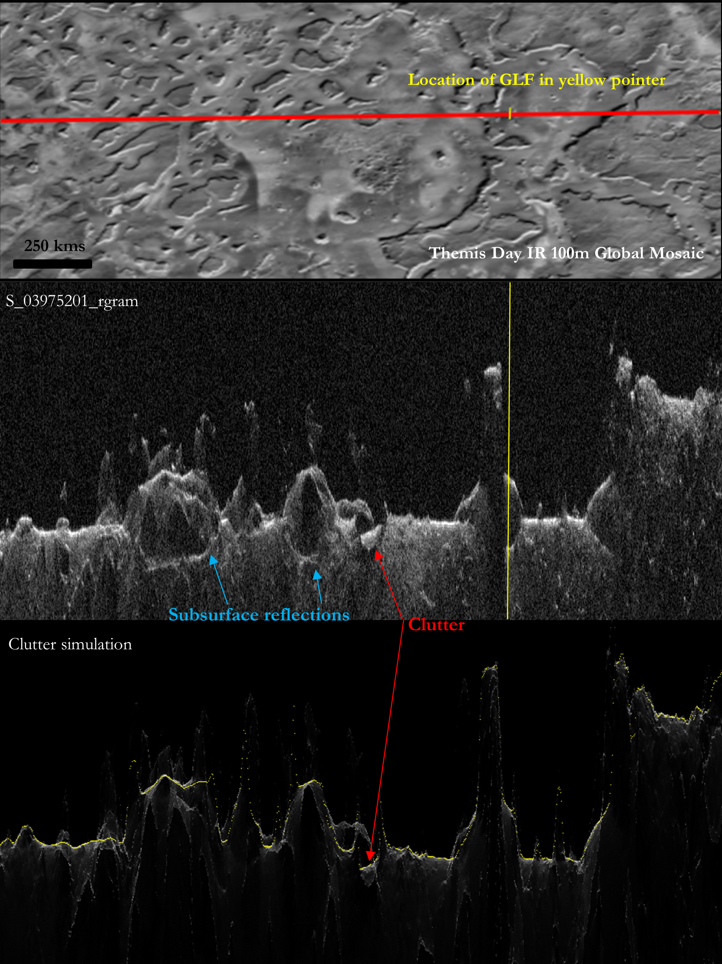
How to cite: Kacholia, D., Bakker, W. H., and Aghababaei, H.: Subsurface layer investigation of the glacial-like forms using SHARAD data, Europlanet Science Congress 2022, Granada, Spain, 18–23 Sep 2022, EPSC2022-382, https://doi.org/10.5194/epsc2022-382, 2022.
The increasing availability of radar sub-surface/surface imaging of the terrestrial planets allowed to highlight the structural architecture of buried geological structures. The reconstruction of the 3D subsurface geometries, besides supporting the classic geologic mapping of planetary surfaces, allows to constrain models to unravel the 4D evolution of a region. This is of utmost importance in key regions where trapped subsurface fluids and their (possible) migration to the surface might impact local/global climate conditions , atmospheric composition, as well as the presence of water close to the maritan surface.
Shallow Subsurface Radar (SHARAD) data [1] revealed that the Martian caps are composed primarily of water ice that was deposited in layers that contain varying amount of dust. They are referred to as martian Polar Layered Deposits (PLD). The internal stratigraphy of these deposits strongly resemble the internal layering in key sites of the East Antarctic Ice Sheet, where the ice tectonics (e.g. ice faulting) and dynamics, revealed to be the causes of the observed architecture.
Mechanisms responsible for the formation and evolution of the martian PLD are still under debate and exogenous processes are considered among the best candidates [2]. Steep troughs dissecting the polar ice caps with spiral shapes provide an optimal view of the layered internal structures. Ice reflectors interpretations suggested a migration of these troughs accompanied by katabatic winds that produce erosion/sublimation at the exposed layers and accumulation/deposition at the opposite slopes [2]. Nevertheless, the SHARAD profiles crosscutting these canyons revealed the lateral change in thickness of ice layers, with thickening as they approach the canyon structures (Fig.1). It is well known from the terrestrial analogues/structures that such geometry may well result from the activity of normal faults with sintectonic sedimentation (ice and dust deposition in the martian case).
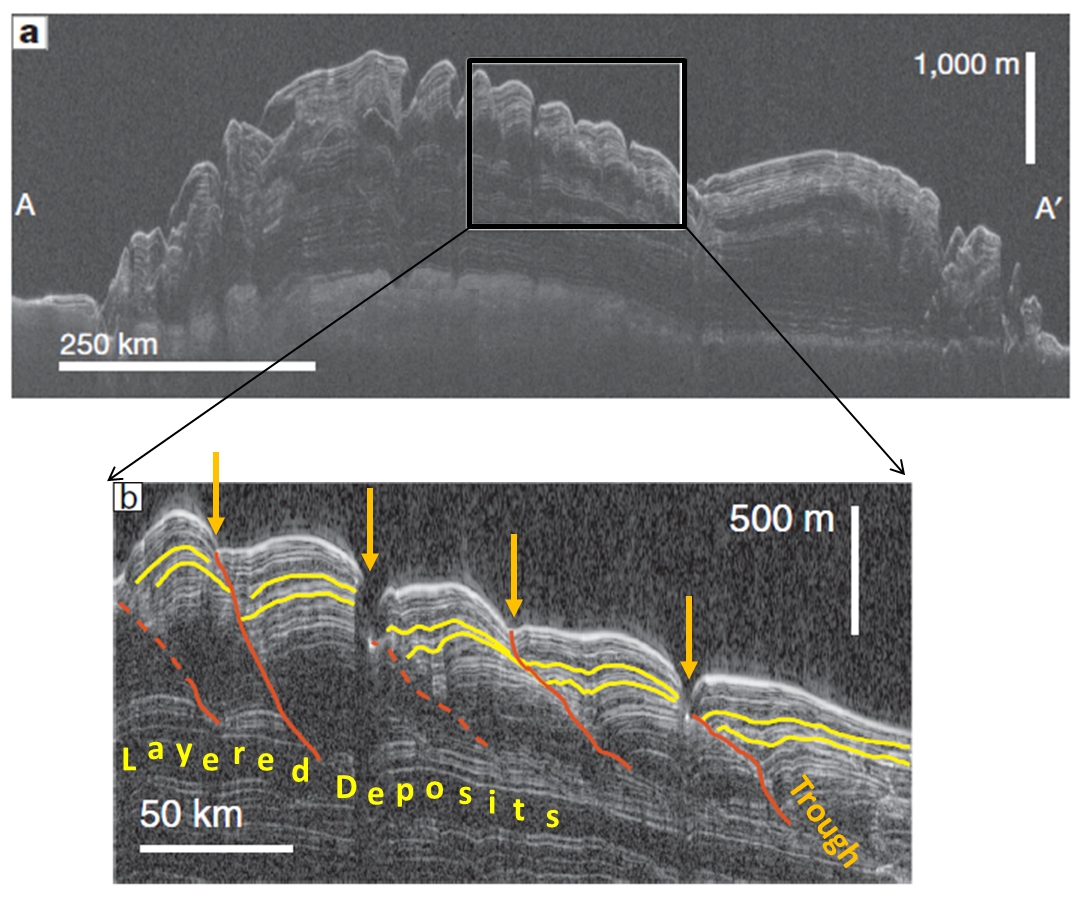
Figure 1. Sharad Image showing examples of the stratigraphic architecture of the North Polar Layered Deposits and spiral through dissecting the ice cap.
In this work we present the results the forward numerical modeling by HCA technique [3] of the PLD structure evolution.. The layered ice is simulated by a mesh of cells whose links replicate the physical and rheological characteristics of the material as well as the presence of ruptures such as faults. The observed ice stratigraphy of the PLD, the lateral thickness variations, and their vertical offset are successfully simulated through the activity of shear discontinuities with a series of listric shapes and normal displacements (Fig.2).
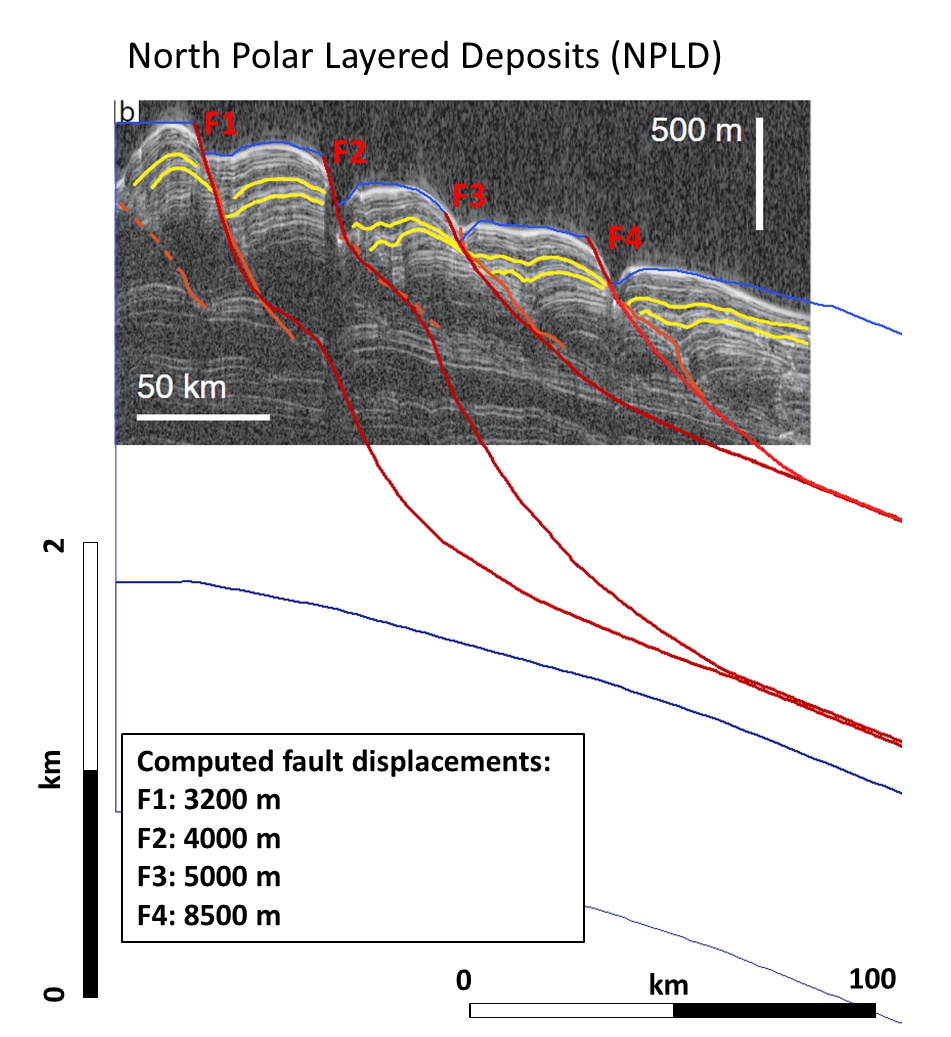
Figure 2. HCA numerical model of the ice layered deposits from Mars north polar region. Subset of SHARAD radargram 1294501 [3]
The HCA kinematic modeling thus revealed the existence faults with size of the order of hundreds of km within the Martian ice caps. Faults with similar size and displacement of the order of several kms are associated with well developed and extended fault core and damaged zones, characterized by strong variation in permeability due to secondary fracturing. In this way the martian ice cap faults produce corridors of brittle deformation that dissect the entire ice cap, provide conduits for fluid migration, and enhance the development of the observed troughs.
The width of the fault damaged zones is of the order of the hundreds of meters and the presence of the fault core, the attitude of fault-related fractures (synthetic fractures, antithetic fractures, extensional fractures, pressure solutions seams) and their spatial distribution and frequency in the ice volume affected by the damage zone of the shear discontinuities has been quantified by the analytical-numerical modeling performed with FRAP software using the found fault geometry [4]. This model takes into account the kinematic conditions of the modeled fault, the physical properties of the ice material and environmental parameters (e.g. acting stresses, gravity, fluid pressure …) which influence the computation of the secondary permeability (Fig 3).
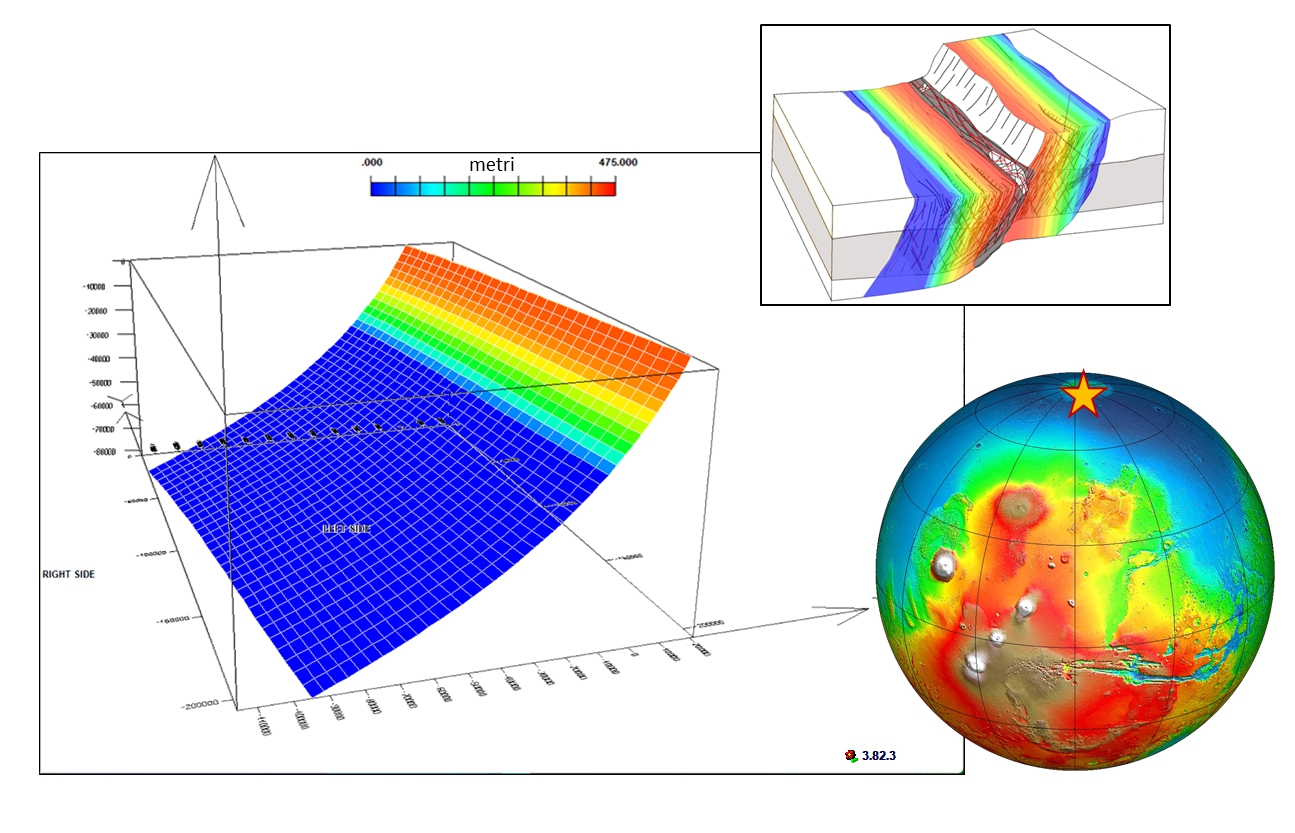
Figure 3. Schematic 3D sketch showing the ice volume affected by fault-related fractures and the development of secondary permeability in the fault damage zone (example of FRAP output).
Results of this study represent a contribute to better understand the hitherto underestimated ice tectonic setting of the Martian ice caps. Highlighting the hydraulic properties of these faults is pivotal to understand the enhanced pathway of fluid that are trapped both within the ice layers and at the base of the ice caps. Fluids and biological material can thus approach the surface and the atmosphere and may be easily detectable/sampled to improve the success of future onland missions.
References
[1] Seu, R., Biccari, D., Orosei, R., Lorenzoni, L. V., Phillips, R. J., Marinangeli, L., ... & Zampolini, E. (2004). SHARAD: The MRO 2005 shallow radar. Planetary and Space Science, 52(1-3), 157-166.
[2] Smith, Holt, Spiga, Howard, Parker (2013). The spiral troughs of Mars as cyclic steps. Journal Of Geophysical Research: Planets, 118, 1835–1857.
[3] Salvini F. Storti F., McClay K (2001)) Self-determining numerical modeling of compressional
fault-bend folding. Geology, 29, 839-842.
[4] Salvini F. (2005). FRAP – Fault-Related fracturing by Analytic-numerical aPpproach. Inhouse developed application at the GEoQuTe Lab, Roma Tre University.
How to cite: Cianfarra, P., Salvini, F., Balbi, E., and Maggi, M.: Structural glaciology of the Martian ice caps unveils conduits for fluid migrations, Europlanet Science Congress 2022, Granada, Spain, 18–23 Sep 2022, EPSC2022-844, https://doi.org/10.5194/epsc2022-844, 2022.
Introduction
The structural modeling of lobate scarps, the topographic effect of surface breaking large thrust faults, have been accomplished by different techniques. 2D Mechanical forward dislocation models (Grott et al., 2007; Ruiz et al., 2008; Egea-Gonzalez et al., 2017, Herrero-Gil et al., 2019) and 2D balance area models (Mueller et al. 2014, Herrero-Gil et al., 2019) were applied to Martian lobate scarps. The recent development of robust 3D structural modeling software (MOVETM software suite, Petroleum Experts Ltd.; used for this study through the Academic Licence of the Universidad Complutense de Madrid) have allowed a more detailed 3D modeling approach that was successfully applied to Ogygis Rupes (Herrero-Gil et al., 2020a) and the Amenthes Thrust Fault System (Herrero-Gil et al., 2020b). Here we show the results of the obtained 3D structural models for 3 thrust faults at the southern boundary of the Warrego Rise (i.e. the boundary between the Thaumasia highlands and the adjacent Aonia Terra to the South) and the two main faults that make up Phrixi Rupes (located in Aonia Terra) (Fig.1).
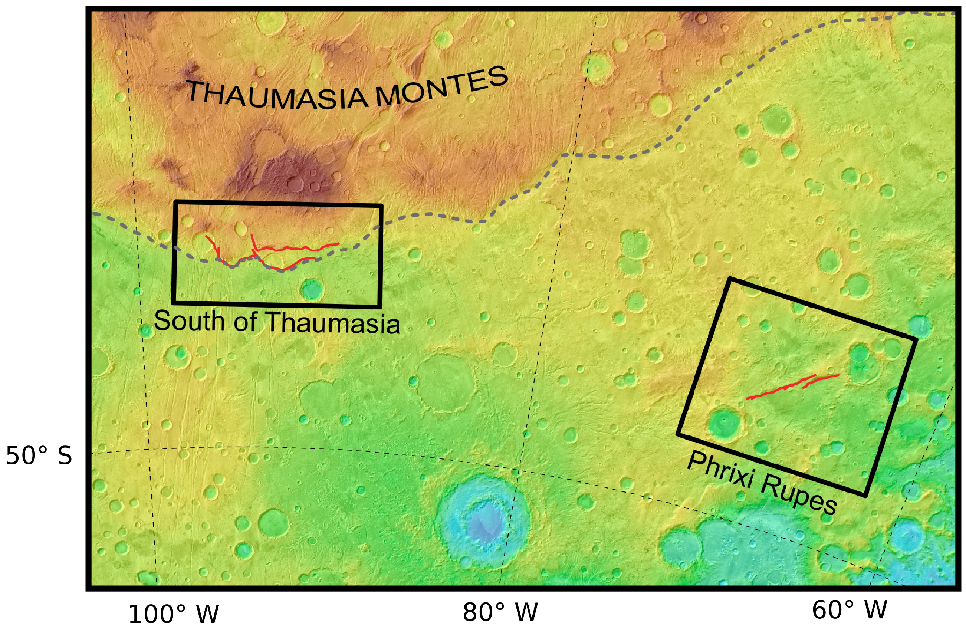
Figure 1. Location of the studied thrust fault
Method
The structural modeling procedure consists in a pure geometrical approach assuming volume conservation. The deformation of the hanging wall is reproduced by fault parallel flow (Egan et al., 1997; Ziesch et al., 2014) and the propagation folding is modeled following the trishear algorithm (Erslev, 1991; Allmendinger, 1998). Full details of the modeling procedure can be found in Herrero-Gil et al. (2020a,b).
Structural modeling of thrust faults at the southern boundary of Warrego Rise
Three faults, producing the main thrusting of Thaumasia's Noachian basement over Aonia Terra, have been modeled in this area (Fig. 2). The obtained maximum fault slips range between 3366-2431 m, the fault dips of the upper planar part range from 33º to 40º, and the depths of faulting from 13 to 27 km. All the studied faults show listric geometries at depth indicating that they root at a detachment level.
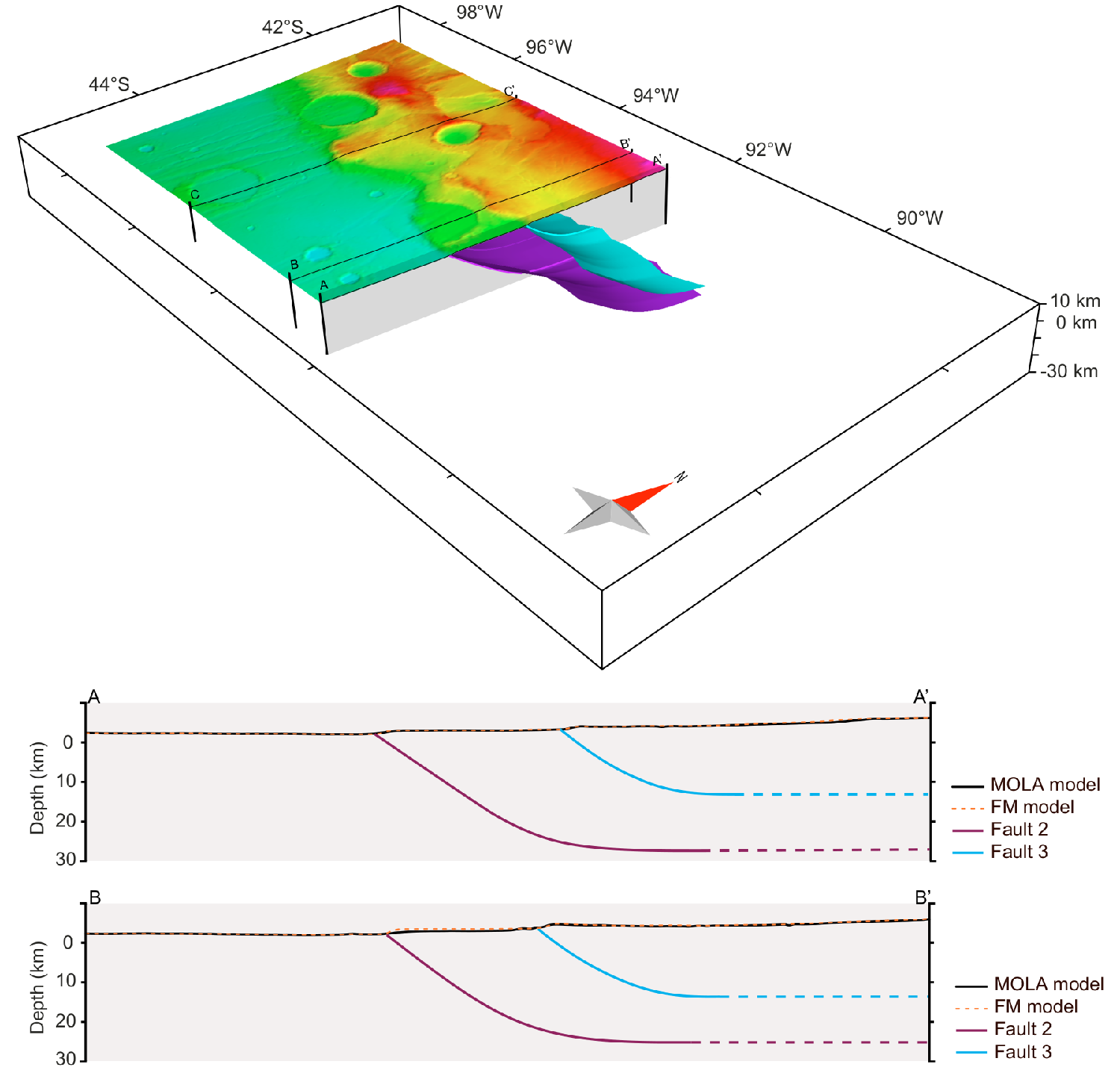
Figure 2. 3D model of the Warrego Rise thrust faults
Structural modeling of the thrust faults of Phrixi Rupes
Two large faults generating Phrixi Rupes have been modeled (Fig.3). Their modeled maximum slips are 2847 m and 801 m, with common dip angles for the upper planar part of 33º-33,6º and depths of faulting ranging from 16 to 19 km.
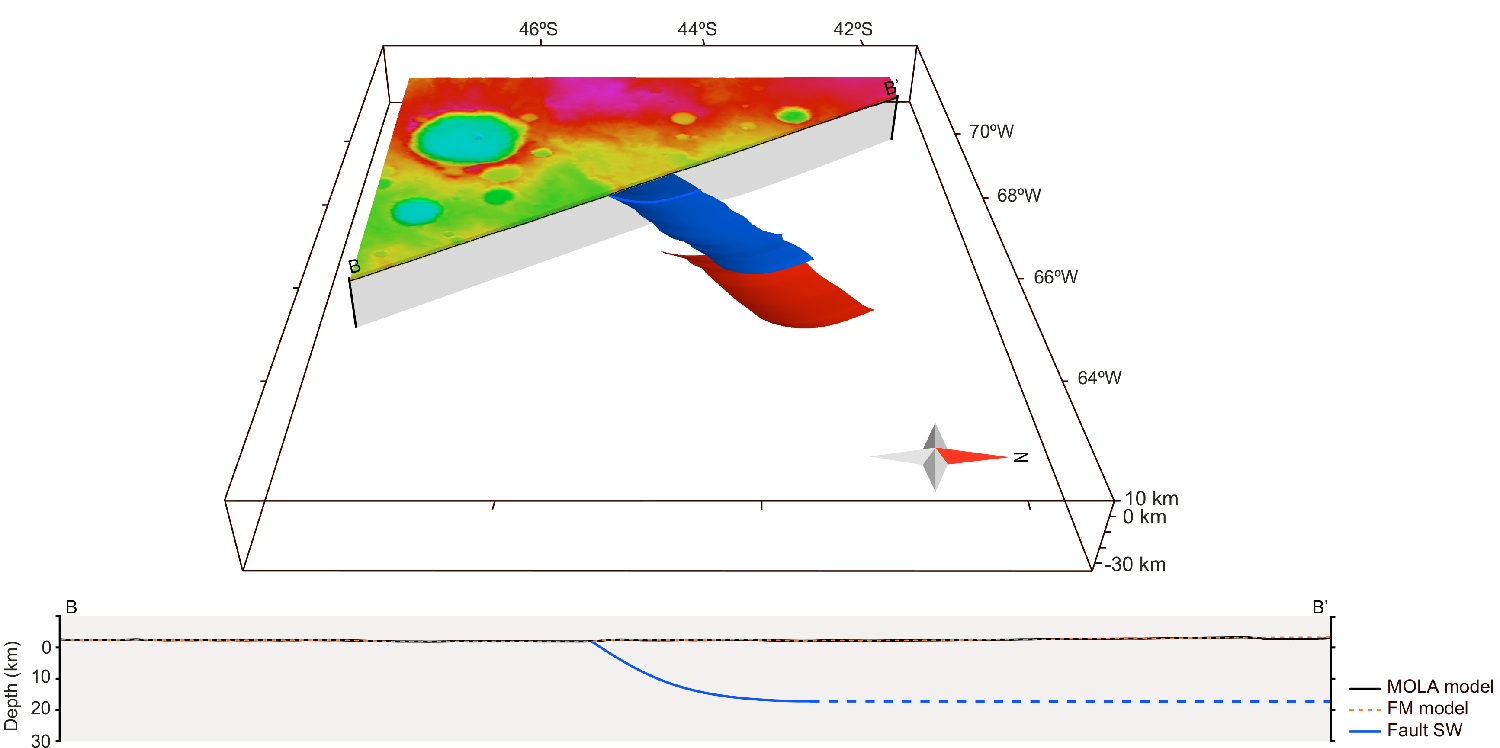
Figure 3. 3D model of Phrixi Rupes thrust faults
Implications for the Circum-Tharsis tectonic contraction
The modeling results of this study together with the model for Ogygis Rupes (Herrero-Gil et al., 2020a) show some remarkable characteristics common to all the studied faults in this area: (1) all the main faults (excluding two subsidiary backthrusts in Ogygis Rupes) show an out-of-Tharsis vergence, (2) all of them have listric geometries at depth suggesting that they root at a detachment plane, (3) the depth of faulting of the main faults gets shallower in an out-of-Tharsis direction. Thus, our 3D structural modeling results support a common detachment level for all the modeled structures controlling a thick-skin tectonic style.
References
Allmendinger, R. (1998). Inverse and forward numerical modeling of trishear fault-propagation folds. Tectonics 17 (4), 640–656.
Egan, S.S., Buddin, T.S., Kane, S.J., Williams, G.D. (1997). Three-dimensional modelling and visualization in structural geology: new techniques for the restoration and balancing of volumes. In: Proceedings of the 1996 Geoscience Information Group Conference on Geological Visualization. In: Electron Geology, 1, 67–82.
Egea-González, I., Jiménez-Díaz, A., Parro, L. M., López, V., Williams, J.-P., Ruiz, J. (2017). Thrust fault modeling and Late-Noachian lithospheric structure of the circum-Hellas region, Mars. Icarus, 288, 53–68.
Erslev, E. (1991). Trishear fault-propagation folding. Geology 19, 617–620.
Grott, M., Hauber, E., Werner, S. C., Kronberg, P., Neukum, G. (2007). Mechanical modeling of thrust faults in the Thaumasia region, Mars, and implications for the Noachian heat flux. Icarus, 186(2), 517–526.
Herrero-Gil, A., Egea-González, I., Ruiz, J., Romeo, I. (2019). Structural modeling of lobate scarps in the NW margin of Argyre impact basin, Mars. Icarus 319, 367–380.
Herrero-Gil, A., Ruiz, J., Romeo, I. (2020a). 3D modeling of planetary lobate scarps: The case of Ogygis Rupes, Mars. Earth and Planetary Science Letters, 532, 116004.
Herrero‐Gil, A., Ruiz, J., Romeo, I. (2020b). Lithospheric contraction on Mars: a 3D model of the Amenthes thrust fault system. Journal of Geophysical Research: Planets, 125(3), e2019JE006201.
Mueller, K., Vidal, A., Robbins, S., Golombek, M., West, C. (2014). Fault and fold growth of the Amenthes uplift: Implications for Late Noachian crustal rheology and heat flow on Mars. Earth and Planetary Science Letters, 408, 100–109.
Ruiz, J., Fernandez, C., Gomez-Ortiz, D., Dohm, J.M., Lopez, V., Tejero, R. (2008). Ancient heat flow, crustal thickness, and lithospheric mantle rheology in the Amenthes region, Mars. Earth Planet. Sci. Lett. 270, 1–12.
Ziesch, J., Tanner, D.C., Krawczyk, C.M. (2014). Strain associated with the Fault-Parallel Flow algorithm during kinematic fault displacement. Math. Geosci. 46, 59–73.
How to cite: Herrero-Gil, A. and Romeo, I.: 3D Structural modeling of large thrust faults in Warrego Rise (southern Thaumasia) and Phrixi Rupes (Aonia Terra), Mars: implications for the architecture of a thrust fault system concentric to Tharsis., Europlanet Science Congress 2022, Granada, Spain, 18–23 Sep 2022, EPSC2022-388, https://doi.org/10.5194/epsc2022-388, 2022.
Introduction: The Moon exhibits globally dispersed tectonic landforms due to thermal contraction, solid-body tides, and loading of the crust. Wrinkle ridges and lobate scarps are both formed as a result of compressional stresses, however, their appearance and formation mechanisms are different [1-5]. Wrinkle ridges are interpreted as blind thrust faults, where horizontal shortening is accommodated by a fault that does not reach the surface. These faults are suggested to extend to depths between 100’s of meters to several kilometers [6-8]. It is thought that wrinkle ridges formed 0.1-0.65 Ga after basalt emplacement as a result of basin subsidence [6-11]. Lobate scarps on the other hand are among some of the youngest landforms on the Moon, with derived model ages < 700 Ma [12-16]. The faults that created the scarps are thought to offset the upper kilometer of the crust and are predominately in the highlands [15-16]. While wrinkle ridges and lobate scarps are typically not co-located, global mapping revealed at least nine cases where wrinkle ridges transition to lobate scarps at a mare-highland boundary [5,16-18]. These transitions are of interest as they are complex examples of recent tectonism [18-20].
The ridge-scarp transition in eastern Mare Serenitatis (21.7°N, 28.9°E) ruptures the surface at a contact between mare basalts and dark mantle deposits, approximately 70 km NW of the Apollo 17 landing site. The ridge is part of the southern section of the Dorsa Aldrovandi ridge system. Derived model ages for the mare units range from ~3 – 3.8 Ga [21], while the ridge-scarp transition has been active in the last 100 Ma [18]. Detailed mapping around both the ridges and scarp revealed a large network of small-scale graben. To better understand the relationship between the small extensional features and the compressional landforms, a geomorphologic map was produced as a first order investigation.
Data and Methods: We used NAC (Narrow Angle Camera; 1 m/pixel) image data from the Lunar Reconnaissance Orbiter Camera (LROC) with incidence angles of 60-75° for detailed geomorphological mapping [22]. The geomorphologic units and landforms were mapped on the basis of their morphology and albedo (Fig. 1). Wrinkle ridges, lobate scarps and small-scale graben are the mapped tectonic landforms as well as two volcanic units: dark mantle pyroclastic deposits and mare deposits. Impact craters were not included into the map.
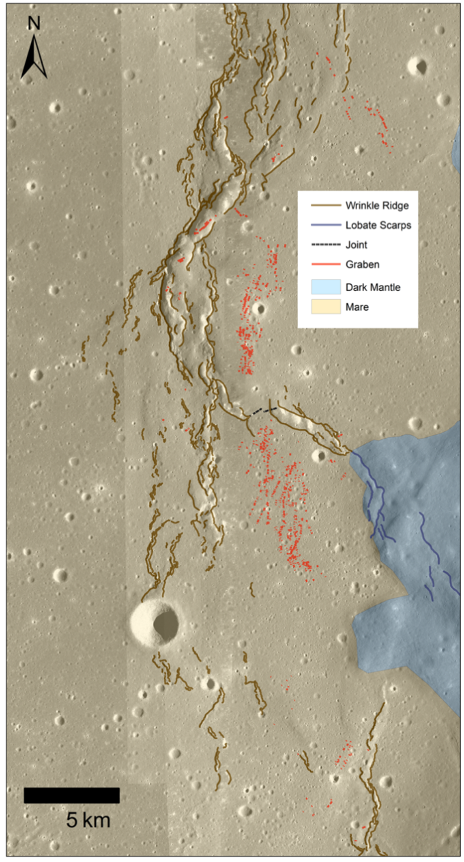
Figure 1: Geomorphologic map of the wrinkle ridge-lobate scarp transition (white arrows) in eastern Mare Serenitatis (21.7°N, 28.9°E) on NAC image data. Brown lines are wrinkle ridge compound scarps, lobate scarps are mapped with blue lines, and small-scale graben are shown with red lines, dashed black lines are joints. Tan color represents the mare, while the light blue areas are dark mantle deposit
Geologic Interpretations (Fig 1.): The wrinkle ridges exhibit typical sinuous and braided morphology [10]. Many ridge sections are discontinuous with some segments as short as 1-2 km in length. The summits of the wider ridge segments occasionally host small-graben that are oriented along strike. Where the ridge crosses the mare-pyroclastic boundary the fault transforms into lobate scarp morphology, likely due to differences in substrate strength and or fault structure. Here, the scarps are simple, curvilinear landforms. The small graben (Fig. 2) are contained within the mare and are mostly tens of meters in length. Graben widths are only a few meters wide and either exhibit typical flat-floors bounded by an escarpment on both sides or v-shaped troughs with irregular edges.
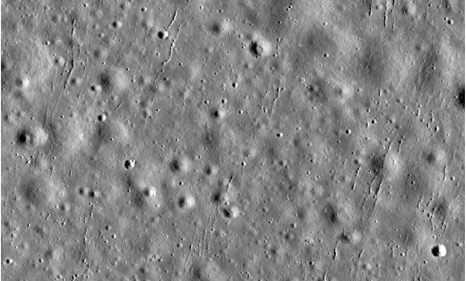
Figure 2: Small-scale graben (21.7º, 28.7º) just south of the ridge section of the transition are approximately perpendicular to the fault.
A smaller ridge, which we tentatively mapped as a joint, traverses the gap (relay ramp) between two segments of the main wrinkle ridge complex and is perpendicular to the main wrinkle complex.
Discussion: Located around the compressional landforms are small-scale graben (Fig. 2). These graben are often found in other locations across the Moon and have been suggested to be the result of localized flexural bending or dilation from recent fault movement at compressional landforms, and are typically found in clusters of ≤20 [23, 24]. However, the graben here occur as a relatively large network (n=991) that spans over ~25 km and they likely formed as a secondary effect (extension) of recent tectonism in the ridges and scarps. These graben have a strong SSW-NNE orientation, which is roughly perpendicular to the section of the wrinkle ridge that transitions into a lobate scarp and parallel to the main Dorsa Aldrovandi ridge. Graben are also observed on the crests of the wrinkle ridges due to extension on the ridge and lateral extrusion of wedge material.
Conclusion: In addition to the late-Copernican ages determined for the wrinkle ridge-lobate scarp transition, the discovery of small-scale graben additionally suggests recent tectonism at the compressional landforms. This supports the hypothesis of a tectonically active Moon [5, 13, 19, 20, 24] that produces not just compressive, but also extensional landforms.
References: [1] Watters & Schultz (2010) Planetary Tectonics, Cambridge Univ. Press. [2] Schultz (1976) Moon Morphology, University of Texas Press. [3] Binder (1982) Earth, Moon, and Planets, 26. [4] Watters and Johnson (2010) Planetary Tectonics, Cambridge Univ. Press. [5] Watters et al. (2010) Science, 329. [6] Schultz (2000) JGR, 105, E5. [7] Solomon and Head (1979) JGR, 84. [8] Watters (1993) JGR-Planets, 98. [9] Solomon and Head (1980) Rev. Geophys. Space Phys., 18. [10] Plescia and Golombek (1986) GSA Bull., 97. [11] Yue et al. (2017) LPSC, #1926. [12] Binder and Gunga (1985) Icarus 63. [13] van der Bogert et al. (2018) Icarus 306. [14] Clark et al. (2015) LPSC, #1730. [15] Clark et al. (2016) LPSC, #1380. [16] Watters et al. (2015) Geology 43, 10. [17] Thompson et al. (2017) LPSC, #2665. [18] Clark et al (2019) LPSC, #2084 [19] Clark et al. (2017) LPSC, #1001. [20] Williams et al (2019) Icarus 326. [21] Hiesinger et al. (2000) JGR, 105. [22] Robinson et al. (2010) Space Sci. Rev. 150. [23] Watters et al (2012) Nature Geo. Sci. 5. [24] French et al (2015) Icarus 252.
How to cite: Clark, J. D., Bernhardt, H., and Robinson, M. S.: Extensional Features at East Serenitatis Wrinkle Ridge-Lobate Scarp Transition Indicate Recent Tectonic Activity, Europlanet Science Congress 2022, Granada, Spain, 18–23 Sep 2022, EPSC2022-757, https://doi.org/10.5194/epsc2022-757, 2022.
Introduction: The occurrence of equatorial layered deposits (ELDs) across Mars are known for their association with water-altered minerals [1]. Various depositional methods have been cautiously proposed [1, 2, 3, 4], but the precise role of water (i.e., duration and intensity) in their deposition remains a compelling and elusive geologic question. It is largely considered that the depositional period took place between the Late Noachian and Middle Hesperian [5]. However, deposition duration is difficult to constrain due to the ELDs spanning several regions across Mars and forming vastly different sized deposits [2]. Thus, there is the possibility of numerous depositions across different regions at varying intervals [3]. Arabia Terra (AT), a heavily cratered dichotomy boundary between the southern highlands and northern lowlands, is home to a plethora of ELDs of various sizes, distributions, deformations, and erosional features [1, 2, 3, 4]. Two of these craters, Sera and Jiji, located in the southern area of AT (Fig. 1a), host a spectacular set of ELDs [2, 3] which are unique in their layering and spatial placement within the craters.
This study examined fold structures within the ELDs of Sera and Jiji to gain a better understanding of ELD composition (specifically grain size), porosity, depositional processes, rate of deposition, and the role of water during deposition and evolution. Our efforts also showcase the potential of classical structural analysis techniques in the field of planetary science.
ELD Deposit: The ELDs within these two craters have unique forms, with the bulk of each deposit residing in the southeast area of the craters. Deposit thickness is approx. 666 m with an average layer thickness of 10.85 m (Sera) and 9.63 m (Jiji) [2]. Garvin equations [6] have demonstrated the possibility of a 579 m thick section that predates the ELDs on top of the crater floor, residing below the observable ELDs [2].
Methodology: A CTX mosaic registered to a HRSC composite DEM [7] forms the base dataset of our study while also utilizing four HiRISE stereo pairs for detailed measurements. A total of 223 layer attitude measurements were obtained using Orion software (Pangaea Scientific) and plotted onto Schmidt nets (Fig. 1e). Strike and dip measurements were overlain on the CTX mosaic (Figs. 1c, d).
Results: A total of eight folds were observed: three synclines, four anticlines, and one monocline (Fig. 1). Their fold axes all share a preferred northwest orientation ranging 297 - 337° (avg. 315.7°) (Fig. 1e). Hinges plunge 2 - 6° (avg. 3.3°) to the northwest. Folds are observed only within the elevation range between -2,500 and -2,300 m and each contain an average of 15 resolvable layers. Fold limb lengths range approx. 120 - 500 m and generally have a 30 – 60 m difference in elevation from the fold hinges. The entire wavelength of the folds Layer attitudes within the fold limbs do exceed 30° in one instance (Fig. 1d), but are generally shallow, ranging 7 - 25°. Fold hinges tend to be preferentially eroded (e.g., Fig. 1d).
Discussion: Due to the collinear nature of the fold axes and the lack of offset layering, there is no evidence of a tectonic origin of these folds. The plunge of the folds might describe the attitude of bedding before folding, but clearly describes a depositional source from the southeast. Perhaps a syndepositional or immediate post-depositional (i.e. in the case of volcanic ash: immediately after deposition, but prior to heat dissipation) compaction over a pre-existing topography can explain these structures [8]. Buried faults are an attractive explanation, however they would be deep faults, as no faulting is observed in the crater wall or surrounding plateau. Furthermore, in the case of a group of deep collinear faults, they would have likely existed prior to the impact event, as they do not radiate outwards from the crater like impact induced faults [9]. However, the impact could have reactivated them which resulted in a small amount of vertical displacement for fold formation. The amount of water present during deposition, accompanied with the porosity of the material, has many implications for the past climate of Mars, particularly atmospheric pressure. Water within volcanic ash could still be present by the time it reached the craters
Preliminary and future work involve the finalization of a computer model which demonstrates the various possibilities the depositional regime can have to create these folds (i.e., porosity, rate of deposition, compaction factor, and composition), with an emphasis on the duality of aeolian loess vs volcanic ash, and wet vs dry.
References: [1] Andrews-Hanna J. C. et al. (2010) JGR, 115(E6). [2] Schmidt G. et al. (2021) JGR, 126(11). [3] Annex A. M. and Lewis K. W. (2020) JGR, 125(6). [4] Pondrelli et al. (2015) Bulletin, 127(7-8). [5] Carr M. H. and Head J. W. (2010) Earth and Planet. Sci. Letters, 294(3-4), 185-20. [6] Garvin J. B. et al. (2003) VI Internat. Conf. on Mars, 3277. [7] Heather D. et al. (2013a) Eu. Planet. Sci. Conf., 8. [8] Schmidt G. W. et al. (2018) JGR, 123, 2893-2919. [9] Kenkmann T. and Von Dalwigk, I. (2000) Met. and Planet. Sci., 35(6), 1189-1201.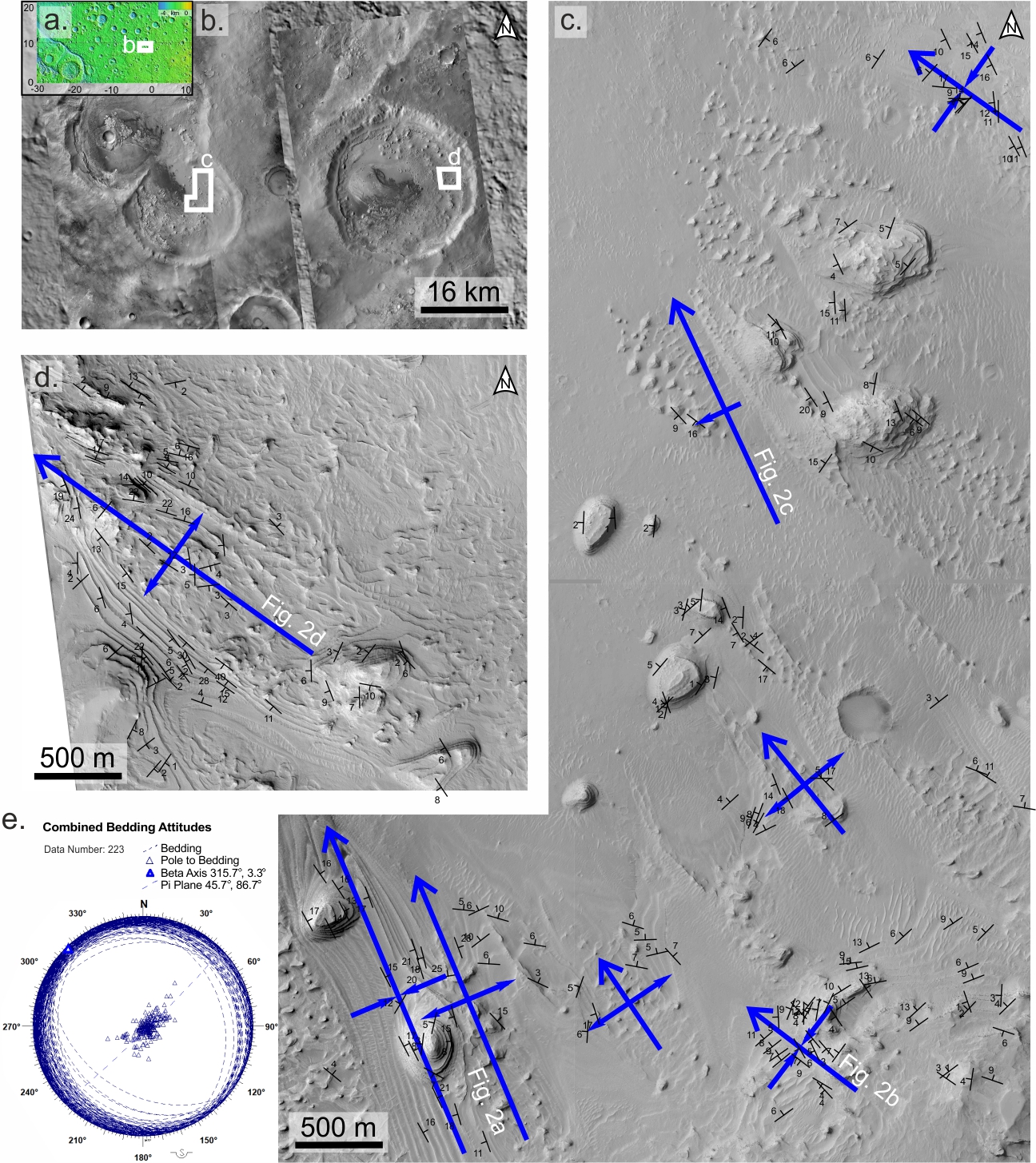
Figure 1. Structural analysis of the ELDs within Sera and Jiji. a) Location of study area in the regional context of AT over a MOLA colorized DEM. White box marks location of figure b. b) CTX mosaic of Sera and Jiji. White box marks location of figures c and d. c) HiRISE stereo pair ESP_017013_1890/ESP_016657_1890 within Jiji. Fold axis locations (blue) and strike and dip measurements (black) marked by their respective symbologies. d) HiRISE stereo pair ESP_057456_1890/ESP_057245_1890 within Sera boasting the steepest dips >35°. e) Schmidt net displaying the combined attitudes from the HiRISE available in both craters (including stereo pairs PSP_002047_1890/PSP_001902_1890 and ESP_037267_1890/ESP_037834_1890).
How to cite: Schmidt, G., Salvini, F., and Apuzzo, A.: Implications for ELD Depostion and Water Content Based on the Existence of Collinear Fold Structures, Europlanet Science Congress 2022, Granada, Spain, 18–23 Sep 2022, EPSC2022-892, https://doi.org/10.5194/epsc2022-892, 2022.
Please decide on your access
Please use the buttons below to download the presentation materials or to visit the external website where the presentation is linked. Regarding the external link, please note that Copernicus Meetings cannot accept any liability for the content and the website you will visit.
Forward to presentation link
You are going to open an external link to the presentation as indicated by the authors. Copernicus Meetings cannot accept any liability for the content and the website you will visit.
We are sorry, but presentations are only available for users who registered for the conference. Thank you.
Posters: Thu, 22 Sep, 18:45–20:15 | Poster area Level 1
Introduction: In the Martian North Polar Cap, troughs are formed and enlarged by the erosive action of katabatic winds, blowing perpendicularly with respect to steep edges of the cap. Along these valleys deeper layering of the polar deposits are often exposed making it possible to study the stratigraphy of the upper part of the polar cap [1]. We focused our attention on a 140 km long and 500 m high scarp located in the North-Western edge, facing Olympia Planum, and where part of the North Polar Layered Deposits (NPLD) are exposed. NPLD deposits are finely layered and laterally continuous sequence of light and dark strata with sporadic unconformities in between, whose periodicity has been attributed to climatic and orbital variations [2]. In the polar cap, Tanaka et al. [3] has distinguished different polar units by means of surface image interpretation, hence our scarp exposes Planum Boreum 1 unit overlapped by Planum Boreum 3 unit, both composed of variable ice/dust content, but different thickness. Putzig et al. [4] identified instead seven units inside the polar cap on the basis of the pattern of radar reflections in the radargram-based stratigraphy thanks to the data provided by SHARAD. The stratigraphic sequence of our interest correlates with the upper part of the packet-inter-packet sequence of the unit G by Putzig et al. [4]. The aim of our work is to relate the composition and stratigraphy of the visible layered deposits with the subsurface radar reflectors, using the data acquired by the NASA Mars Reconnaissance Orbiter instruments.
Data selection: We performed stratigraphic and geomorphologic interpretation on images of the Context Camera (CTX) and High Resolution Imaging Science Experiment (HiRISE); band ratios and spectral signatures on a hyperspectral cube of the Compact Reconnaissance Imaging Spectrometer for Mars (CRISM); subsurface reconstructions on radar reflectors obtained by the Shallow Radar (SHARAD). The integration of the results obtained by such a multi-score data-set underlies the possibility to join the SHARAD stratigraphy with the stratigraphic record recognisable at the surface including its compositional variability (Fig.1).
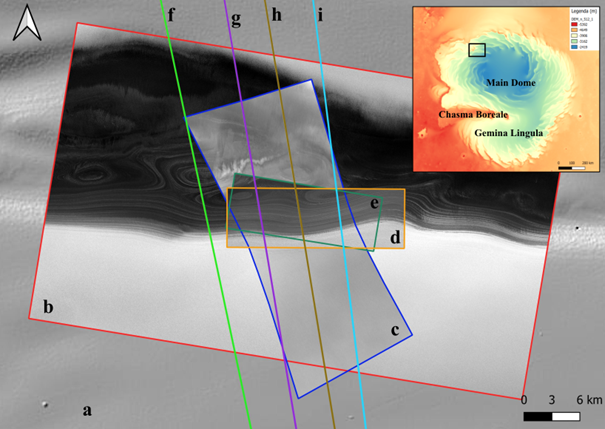
Fig.1 – Data-set: MOLA DEM (a), CTX image (b), CRISM cube (c), HiRISE images (d, e) and SHARAD radargram tracks (f, g, h, i). Black rectangle in the North Polar Cap region shows the study area.
Spectral analysis: Spectra for five Regions of Interest (ROIs) of about 50 pixels were acquired and are shown in Fig.2a-b.
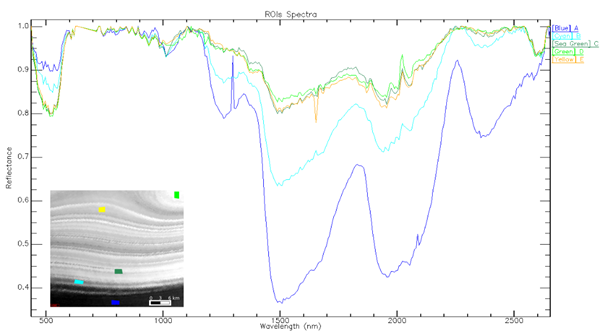
Fig.2 – (a) Regions of Interest over CRISM image detail; (b) Plot of five ROI average spectra: each colour line represents a ROI spectrum (continuum is removed).
The exposed stratigraphy is composed of different amount of dry ice, water ice and basaltic dust [3]. Spectra A and B are well distinguishable, whereas the signatures of C, D and E appear similar, indicating comparable compositions. Spectrum A exhibits well developed water-ice absorption bands (1.5 and 1.95 µm), less development of same peaks might imply an increase of dry ice content. The 1 µm peak (water ice) is well visible in both A and B spectra, but less evident in C, D and E. Multiple absorptions at 1.65 and 2.06 µm, associated to CO2, are well visible in C, D and E. Other absorption bands (at 0.50, 1.02 and 2.30 µm for example) can be related to femic and aqueous alteration minerals. Spectrum A is similar to the signature of pure water ice, with less altered minerals, while C, D and E appear to be characterized by dry ice and femic minerals. Spectrum B appear to be transitional between these two end-members.
Spectral indexes: Spectral indexes were produced using CRISM Analysis Toolkit (CAT) [5]. Indexes allowed us to create false colour images to highlight the presence/absence of specific minerals. Example of these are shown in Fig. 3 (see FED for the index definition).
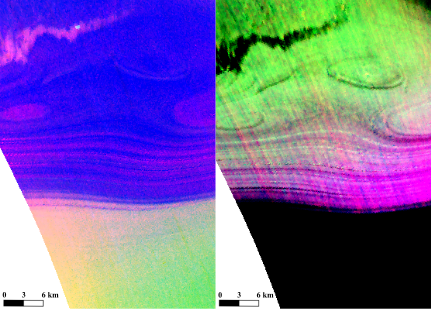
Fig.3 – Two false colour images created with spectral indexes (a) BDI1000VIS_BD15002_BD1435 representing ice compositions and (b) OLINDEX3_LCPINEX2_RBR to highlight mineral composition.
Mapping and correlation to radar reflectors: Geological units were identified on CRISM and CTX data on the basis of morphology, composition, albedo and their stratigraphic relationship. Fig.4 displays the mapped units.
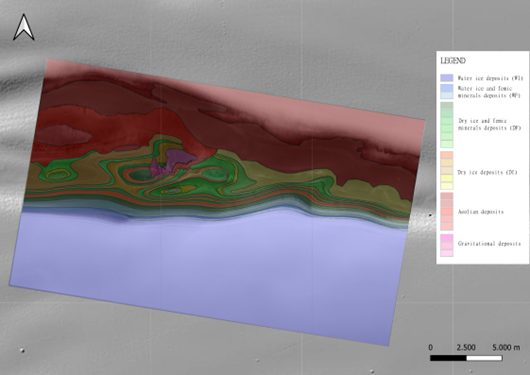
Fig.4 – Geological map and relative units. WI-units: water-ice-rich deposits (blue), WF-unit: water ice and femic minerals deposits (light blue); DF-units: dry ice and femic minerals deposits (green); DI-units: dry-ice-rich deposits (yellow); Aeolian deposits (red); Gravitational deposits (purple).
Fig.5 shows the geological units correlated with radargrams features. Variations of dielectric constant among strata are due firstly to presence of water ice in the surficial layers and dry ice in deeper ones, secondly to different amount of dust in radar units. These affect the signal reflectance: stronger if it is from water-ice layers. Additionally, high content of dust significantly decrease the radar signal, so units appear darker [4] [6]. The lines in Fig.5 represent lower contact of the geological units.
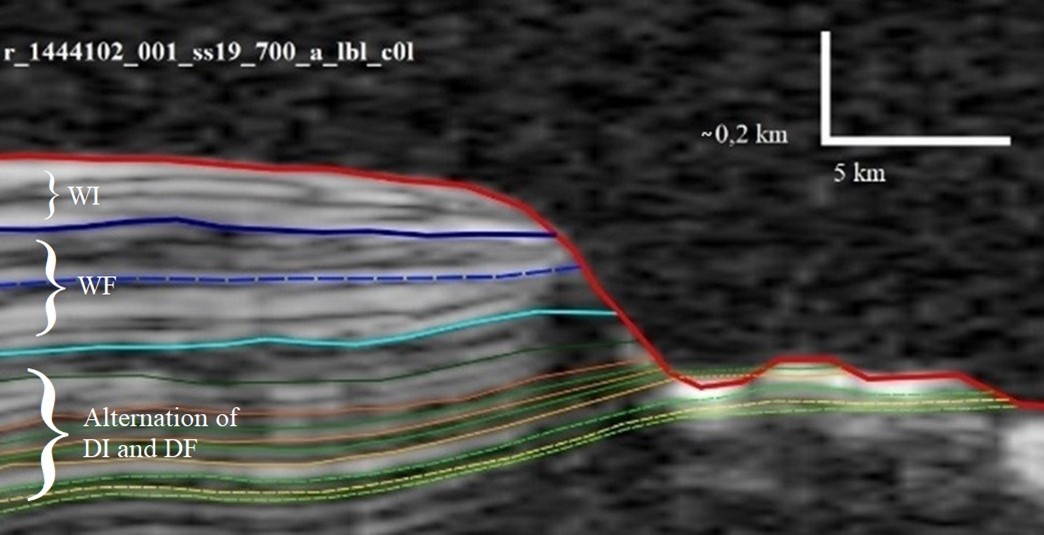
Fig.5 – Correlation between geological units and radar reflectors. The colours of units are the same of geological map (vertical axis in time). Section track is shown in Fig.1.
Discussion and conclusions: We provide a detailed compositional and geometrical characterization (using CRISM, HiRISE, CTX) of outcropping layered deposits of the North Polar Cap, to evaluate the potential for performing sound stratigraphic correlations with the subsurface reflectors identified in SHARAD radargrams. At a scale of single layers, compositional variations of basaltic dust content in the stratigraphic sequence were identified. This variability is visible especially in dry-ice-rich layers. Basaltic dust showed aqueous alteration, especially in water-ice-rich strata.
Acknowledgments: We acknowledge support from the EU’s H2020 research and innovation program under grant agreement N° 871149 (GMAP).
References: [1] Masse, M. et al. (2012) Earth and Planetary Science Letters, 317, doi: 10.1016/j.epsl.2011.11.035; [2] Byrne, S. (2009) Annual Review of Earth and Planetary Science, 37, doi: 10.1146/annurev.earth.031208.100101; [3] Tanaka, K. et al. (2008) Icarus, 196(2), doi: 10.1016/j.icarus.2008.01.021; [4] Putzig, N. et al. (2009), Icarus, 204(2), doi: 10.1016/j.icarus.2009.07.034; [5] Viviano-Beck, C. et al (2014), Journal of Geophysical Research, 119(6), doi: 10.1002/2014JE004627; [6] Lauro, S. et al. (2012), Icarus, 219(1), doi: 10.1016/j.icarus.2012.03.011.
How to cite: Costa, N., Massironi, M., Penasa, L., Nava, J., Pozzobon, R., and Ferrari, S.: Compositional and subsurface analysis of an outcrop close to Olympia Planum on Mars, Europlanet Science Congress 2022, Granada, Spain, 18–23 Sep 2022, EPSC2022-167, https://doi.org/10.5194/epsc2022-167, 2022.
The ExoMars rover mission will be looking for biosignatures (i.e. signs of past and present life) in Oxia Planum, Mars [1]. The landing site is located between 16° and 19° N and 334° to 337° E where the ancient cratered terrains transition into the low-lying plains of Chryse Planitia. The area of interest is situated between Ares Vallis and Marwth Vallis in a wide basin at the outlet of Cogoon Vallis. The fractures, extensively spread over the terrains of the landing site, range from meters to decameters in spacing and length and have been preliminary interpreted as desiccation cracks or the result of burial and unloading of sediments [2,3]. We mapped these fractured terrains and we tested an automatic method for alignment tracing which contributes to our study in an effort to evaluate the directional aspects of fracturing and their spatial distribution within the study area.
The data we used come from VNIR pushbroom imager camera HiRISE, which produces the highest resolution images of the martian surface (25 to 60 cm/pixel) [4]. 31 greyscale HiRISE RED products (25 cm/pixels) and three HiRISE colour product (60 cm/pixel) covering the landing ellipse were selected and downloaded from the Planetary Data System (PDS) [5], and imported into QGIS (version 3.24.1 Tisler) [6]. To map these fractures over a submeter resolution basemap within the ≥1000 km2 landing ellipse area, we opted to use a 1:5000 scale. We mapped the boundaries of the fractured area as lines, generating category areas from the boundaries of the mapped area through the Mappy QGIS plugin [7]. We classified the fractures by their association with sand, dunes, TARs and ridges. Using the resulting map of the fractured terrains, we placed a 200 m2 Scan Area on a place where fracturing was more evident: we extracted HiRISE data that was input into the Slope Intersect Discrete Analysis (SID) software version 3.04-10 for automatic tracing of the fractures. The results of automatic tracing, whose algorithm is based on a modified Hugh transform [8], was further processed in to GRASS GIS [9]: the GRASS Toolset v.clean was used to snap vertices of SID output. To compare the manual and automatic methods, the Scan Area input by SID has been used to manually trace fractures at 1:1000 scale, whose orientation in the space was obtained using Daisy software version 3-5.51-3. The map of the fractured terrains was then used to place multiple Scan Areas where fracturing is more evident (Fig.2). The automatic fracture tracing method will be applied on other areas of interest in future studies.
We classified fractured terrains into three categories where we placed 28 Scan Areas (Fig.1) : we placed nine of them in terrains characterized mainly by fractures (MF, lower portion of the map), 10 in terrains associated with the presence of linear topographic rises (ridges) (RF, central portion of the map) and nine in fractured terrains with an abundance of sand and dunes (SF, upper portion of the map). 507 fractures were traced manually ranging 1.14-68.4 m in length (Fig.2, b). In the automatic method, SID mapped 1712 elements between 2 and 21 m in length (Fig.2, a). Regarding the directional Azimuth-Frequency analysis carried out by Daisy, the average orientation is very similar: fractures traced manually indicate a value of 92.26° (sd: 12.5°) and fractures traced via SID correspond to a value of 93.06° (sd: 15.97°) (Fig.2, a, b below).
The spatial distribution of fractures traced manually is homogeneous, including both the longest and the shortest fractures. The few areas where the absence of fractures is observed are those where there is a strong cover of sand. The longer fractures do not create intersections, if not with the shorter ones, which cross each other, forming small networks. The homogeneous distribution of manually traced fractures is the same as those traced unsupervised via SID. The differences instead occur mainly in the number and in the length of lines traced in the two methods: SID’s sensitivity to low variations of DN result in a greater number of identified fractures through segments with a defined minimum and maximum length. However, not all manually traced fractures have been identified by SID. No matter how efficient the GRASS GIS toolset is, fractures traced by SID too far apart from eachother were not considered a single element, which the human interpretation would have done. As far as orientation is concerned, the two methods show very similar values.
This study shows how, although the clear differences between manually and automatic method, the latter may prove to be efficient, even considering their limitations. SID’s fracture tracing in fact guarantees a strong effectiveness for the calculation of their orientations. Further analysis in the Scan Areas placed on the fractured terrains of the landing ellipse will verify whether or not there are anisotropies in the orientation of the fractures, which will help improve our knowledge about the formation and evolution of Oxia Planum.
References
[1] Vago et al.(2017), Astrobiology, Vol. 17, No. 6-7. [2] Quantin-Nataf et al. (2021) Astrobiology 21, 345. [3] Bowen et al. (2022) Planetary and Space Science Volume 2014. [4] McEwen et al. (2007) Journal of Geophysical Research: Planets Volume 112, [5] McMahon (1995) Planetary and Space Science Volume 44 [6] Casagrande et al., (2014) Dario Flaccovio Editore p. 220 [7] Penasa et al. (2020) European Planetary Science Congress, Volume 14 [8] Hough (1959) HEACC, Proceedings of the 2nd International Conference on High-Energy Accelerators and Instrumentation [9] Neteler and Mitasova (2013) The Springer International Series in Engineering and Computer Science
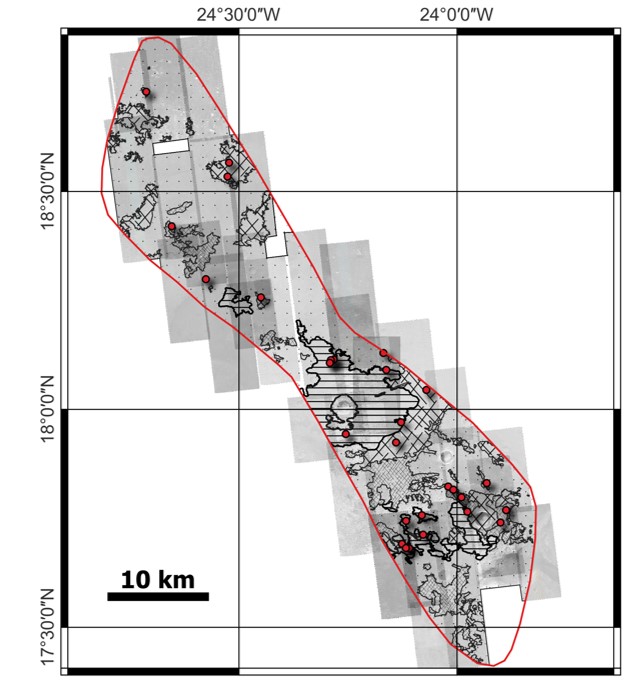
Figure 1 – Fractured terrains mapping and Scan Area locations within the ExoMars landing ellipse. Geospatial data is in simple cylindrical projection, considering Mars Sphere (IAU2018:49910).
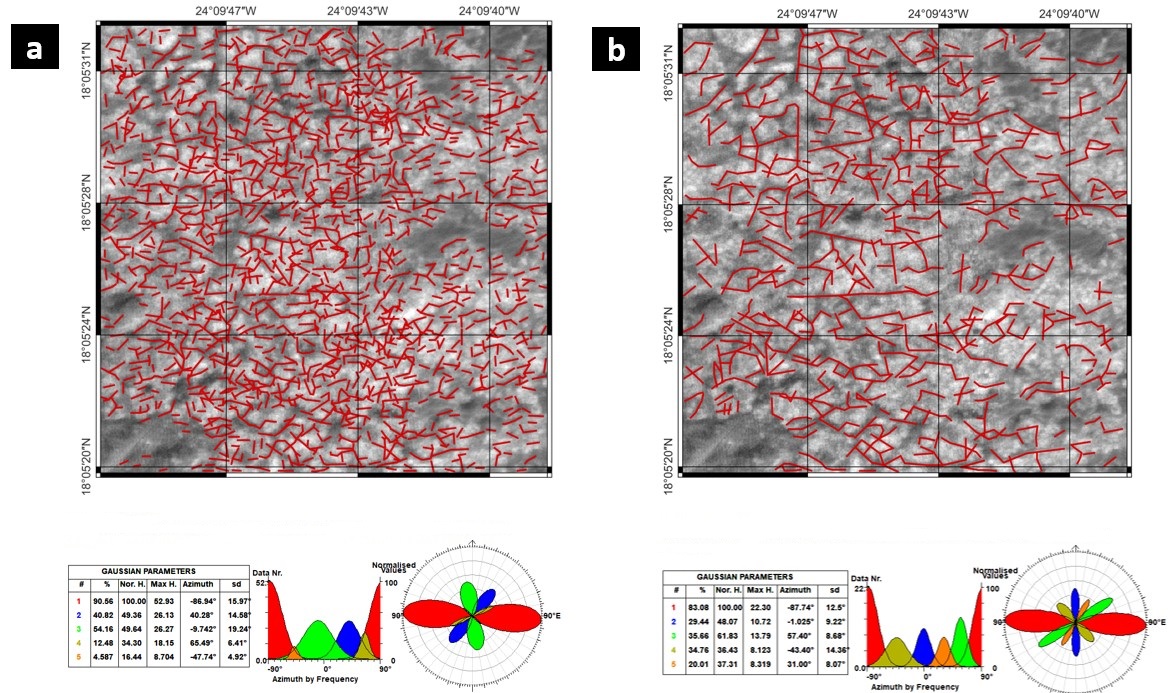
Figure 2 - Comparison between automatic (a) and manual tracing (b). The tables show results of the directional analysis effectuated by Daisy.
How to cite: Apuzzo, A., Frigeri, A., Salvini, F., Brossier, J., De Sanctis, M. C., Costa, N., and Schmidt, G. W.: Automatic Fracture Tracing by Image Processing on Oxia Planum, Mars, Europlanet Science Congress 2022, Granada, Spain, 18–23 Sep 2022, EPSC2022-350, https://doi.org/10.5194/epsc2022-350, 2022.
Introduction
The nature of the stress regime of the martian lithosphere that was active in the Late Noachian-Early Hesperian is a topic of ongoing debate [1]. The duality between the northern lowlands and southern highlands is thought to be a major relic of the early tectonic regime of Mars, however their exact origins and geological history is not fully constrained. Arabia Terra is a region that spans 4850 km across and is located in the transitional zone between the lowlands and highlands. It is known for widespread deposition of layered deposits [2, 3] within craters which are associated with past water activity [4]. Danielson is a 60 km diameter, 2 km deep, crater located in western Arabia Terra and centered at 8°N, 353°E (Figure 1A). The crater is dominated by the presence of a massive layered deposit which exhibits intense faulting and several large folds (e.g. Figure 1B, 1C, 1D).
Danielson is unique to other craters in the region due to its quadrangular shape (Figure 1A and 1B). This shape cannot be easily explained by an impact event. Due to faulting that offsets the layered deposits and the crater rim, and high dips and folds, the crater likely has undergone extensive deformation. Since the deposition of these deposits is considered to have taken place in the Early Hesperian [5], we propose that the quadrangle shape of the crater rim, combined with post-depositional deformational structures, reflects the waning tectonic regimes during the Noachian-Middle Hesperian transition which was possibly a vestige of pseudo plate tectonics that never fully formed. The faulting and folding process may reflect the new successive tectonic regime that post-dates the closure of a pseudo plate tectonic era.
Methodology
An HRSC composite DEM [6] forms the base dataset of our study. We utilized three HiRISE DEMs and one HiRISE image for detailed measurements. 52 layer attitude measurements were obtained using Orion software and evaluated statistically based on strike and dip frequency (Figure 1D). Faults were identified by the lateral offset of layers and linear features. Folds were identified by interpreting large scale structures within layer sequences based on dip directions and 3D scenes.
Results
High layer dips, folds, and widespread faulting were identified and measured within Danielson. Two sets of dips, 4.5° and 19.2°, are present with a maximum dip of 44° (Figure 1D). At least 12 folds were identified, each collinear and alternating from syncline to anticline (e.g. Figure 1E). All folds plunge to the southwest. Fold limbs are approximately 200 m long and contain on average 20 layers. Axial traces have a preferred northeast-southwest orientation. Over a hundred faults have been identified, many propagating through fold hinges (e.g. Figure 1E). Faults have two preferred orientations, northeast-southwest and northwest-southeast. Faults generally offset layering several meters, with some reaching 400 m.
Danielson has a quadrangle shaped crater rim which does not conform to a circle or an oval (Figure 1B). Several regional faults pass through the crater and cross-cut the crater rim. The quadrangle shape and the fault/fold trend are not coaxial, suggesting a rotation in the tectonic stress regime between the two events.
Discussion
Dips are often above the angle of repose for material with a grain size that could be deposited by air or fluid-expulsion (34°). Although there are many factors that contribute to the angle of repose (e.g., grain shape and moisture) [7], we interpret high dips as non syndepositional (i.e. not draping) and representative of a unique post-depositional history. Furthermore, the presence of tight folding in combination with widespread faulting demonstrates a period of intense deformation which possibly indicates regional extension and compression. Subsidence may have had a role in the observed deposit deformation because complex craters have a period of collapse and even uplift after impact, however the timescale of collapse is thought to be shorter in comparison with the accumulation rate of sediments [8].
The quadrangle shape of the crater can be produced by the interaction of the impact stress and the stress regime of the lithosphere present at the time of impact (Middle-Late Noachian; 4.1-3.8 Gya) [9]. In this case it would be expected that the regional stress is characterized by northeast-southwest maximum horizontal extension and northwest-southeast maximum horizontal compression as explained by the contrast of the crater rim slightly changing from round to straight, normal to the extension direction (Figure 1B).
This is further contested by the identification of faults and folds of the younger Early Hesperian aged (3.8 Gya) deposits within the crater that have preferred orientations north-northeast and south-southwest. It is likely that these structures are related to the tectonic regime which was present after the ending of the horizontal movement which produced the quadrangular shape of the crater. This change in the tectonic evolution of the region may well reflect the change from a type of plate tectonics regime to the present static stress.
The stress regime revealed by the asymmetry of the crater can be a reflection of the last global tectonic (i.e. pseudo plate tectonics) framework which at the time of impact was ending. At the time of impact there was likely still a residual stress regime due to the horizontal movement at the boundary of the lowlands and highlands.
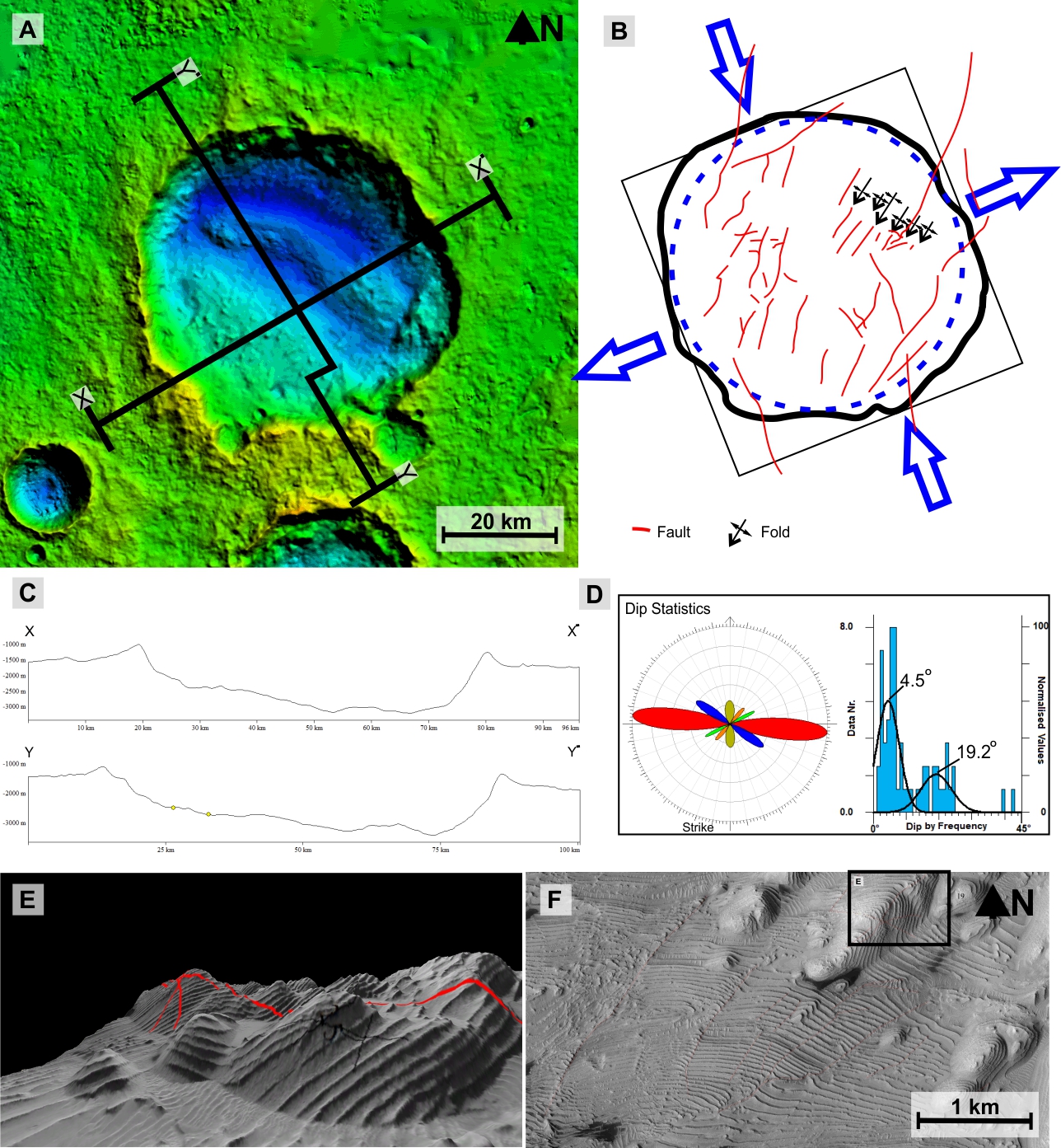
Figure 1.
References
[1] Hauber E. et al. (2010) Earth and Planet. Sci. Letters, 294(3-4), 393-410. [2] Schmidt G. et al. (2021) JGR: Planets, 126(11). [3] Annex A. M. and Lewis K. W. (2020) JGR: Planets, 125(6). [4] Andrews‐Hanna J. C., et al. (2010) JGR: Planets, 115(E6). [5] Carr M. H. and Head J. W. (2010) Earth and Planet. Sci. Letters, 294(3-4), 185-20. [6] Heather D. et al. (2013a) Eu. Planet. Sci. Conf., 8. [7] Al-Hashemi and Al-Amoudi (2018) Powder Tech., 330, 397–417. [8] Melosh, H. J. and Ivanov, B. A. (1999) Annual Rev. of Earth and Planet. Sci., 27(1), 385–415. [9] Tanaka K et al. (2014) U.S. Geological Survey Scientific Investigations Map 3292.
How to cite: Schmidt, G., Trullo, A., Salvini, F., and Apuzzo, A.: Tectonic evolution identified by regional and local structures within Danielson crater, Arabia Terra: Testifying to the waning of pseudo plate tectonics on Mars?, Europlanet Science Congress 2022, Granada, Spain, 18–23 Sep 2022, EPSC2022-706, https://doi.org/10.5194/epsc2022-706, 2022.
Please decide on your access
Please use the buttons below to download the presentation materials or to visit the external website where the presentation is linked. Regarding the external link, please note that Copernicus Meetings cannot accept any liability for the content and the website you will visit.
Forward to presentation link
You are going to open an external link to the presentation as indicated by the authors. Copernicus Meetings cannot accept any liability for the content and the website you will visit.
We are sorry, but presentations are only available for users who registered for the conference. Thank you.
Please decide on your access
Please use the buttons below to download the presentation materials or to visit the external website where the presentation is linked. Regarding the external link, please note that Copernicus Meetings cannot accept any liability for the content and the website you will visit.
Forward to session asset
You are going to open an external link to the asset as indicated by the session. Copernicus Meetings cannot accept any liability for the content and the website you will visit.
We are sorry, but presentations are only available for users who registered for the conference. Thank you.
